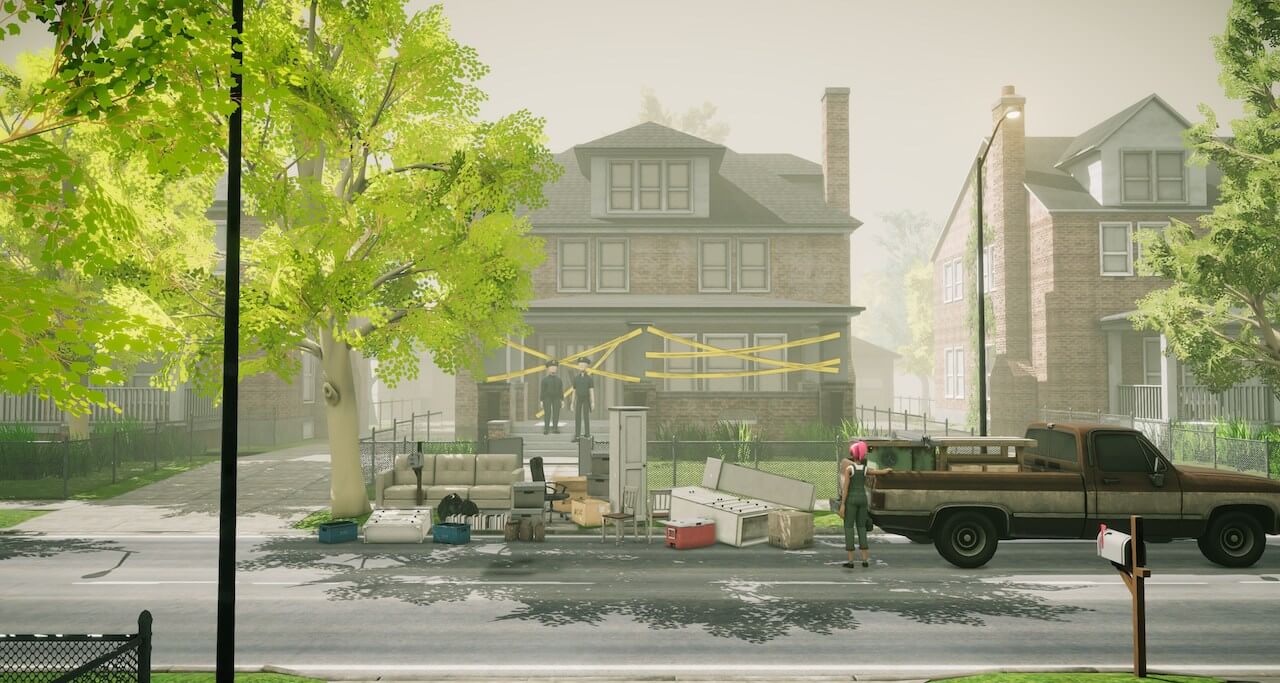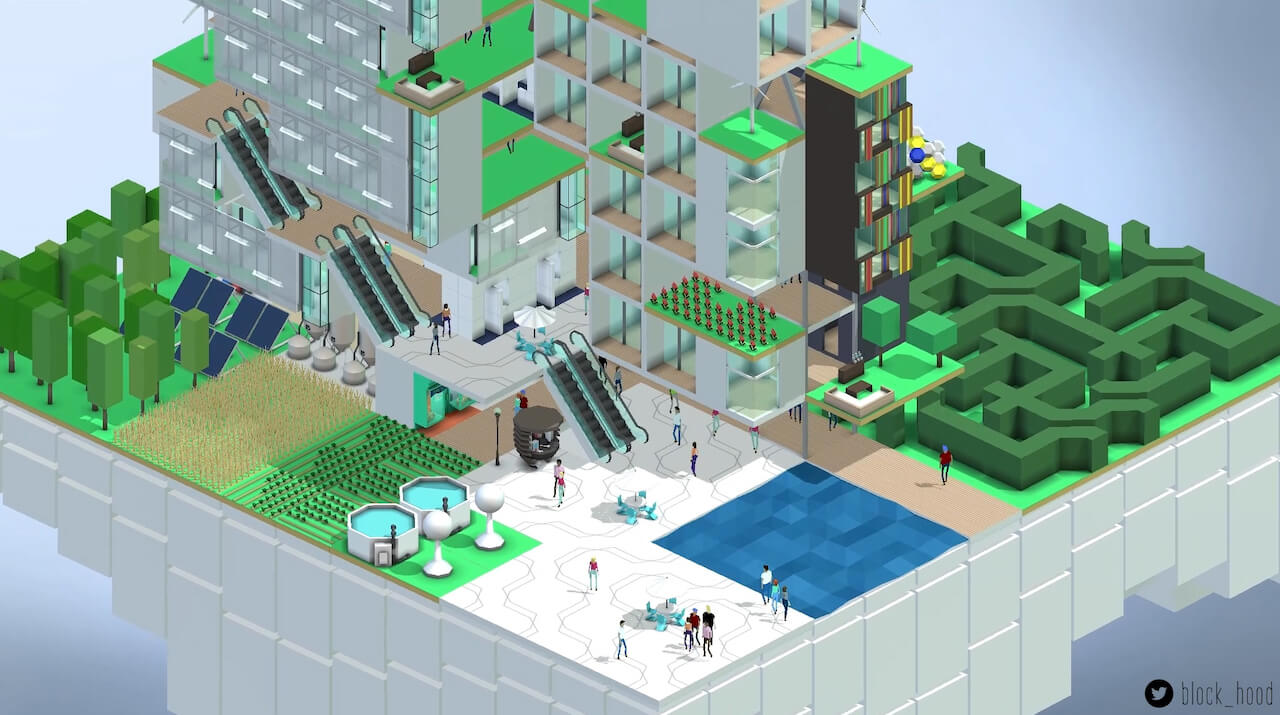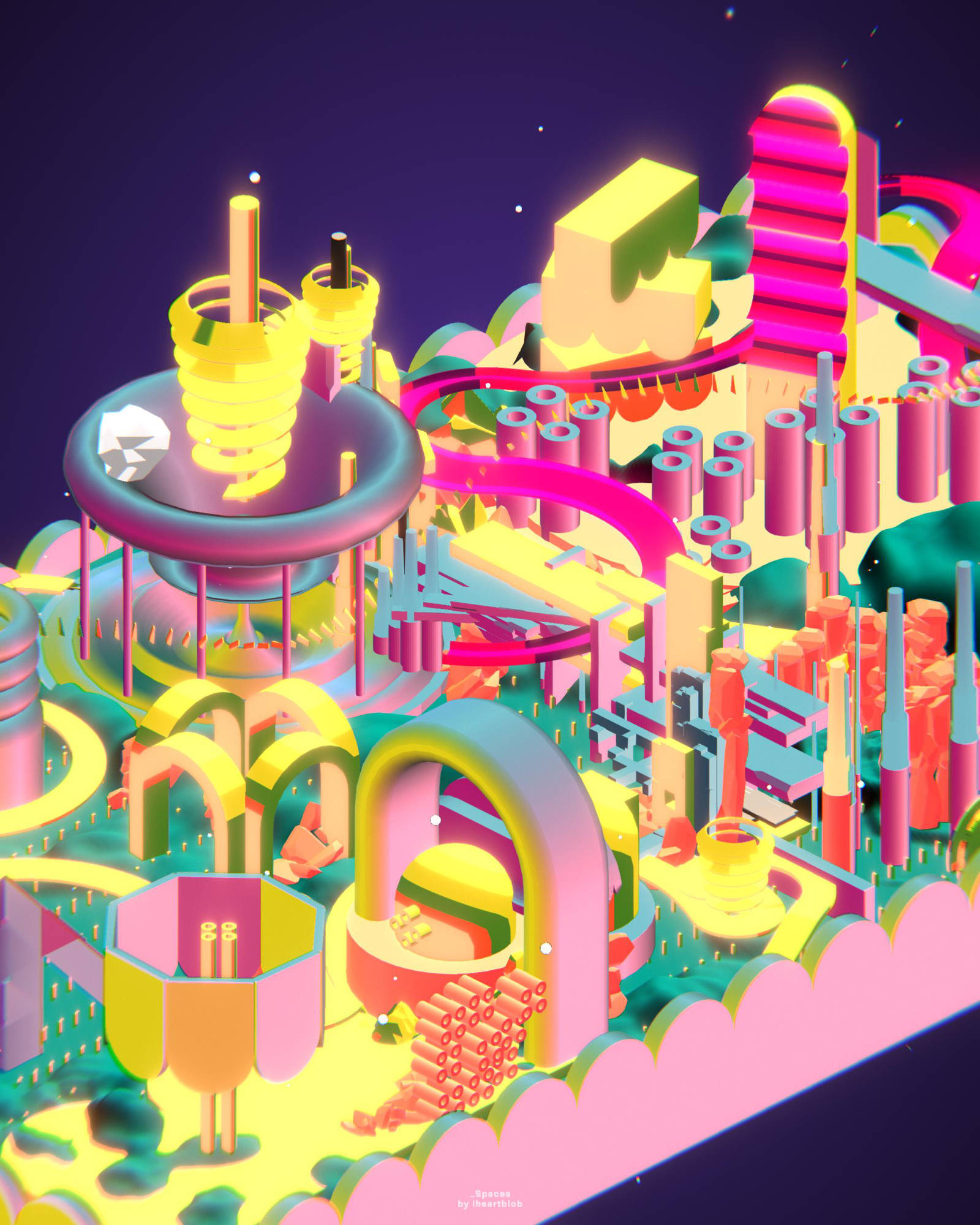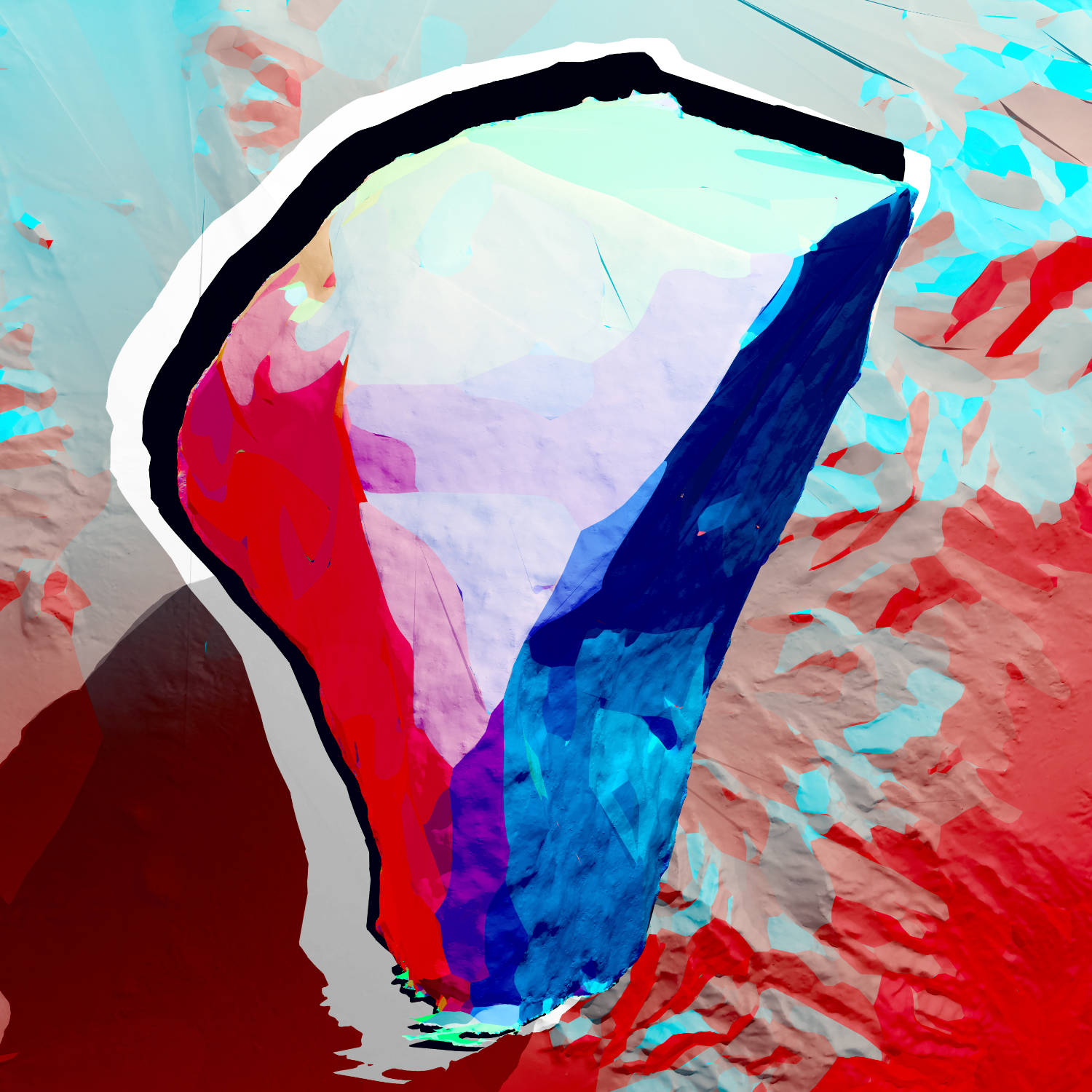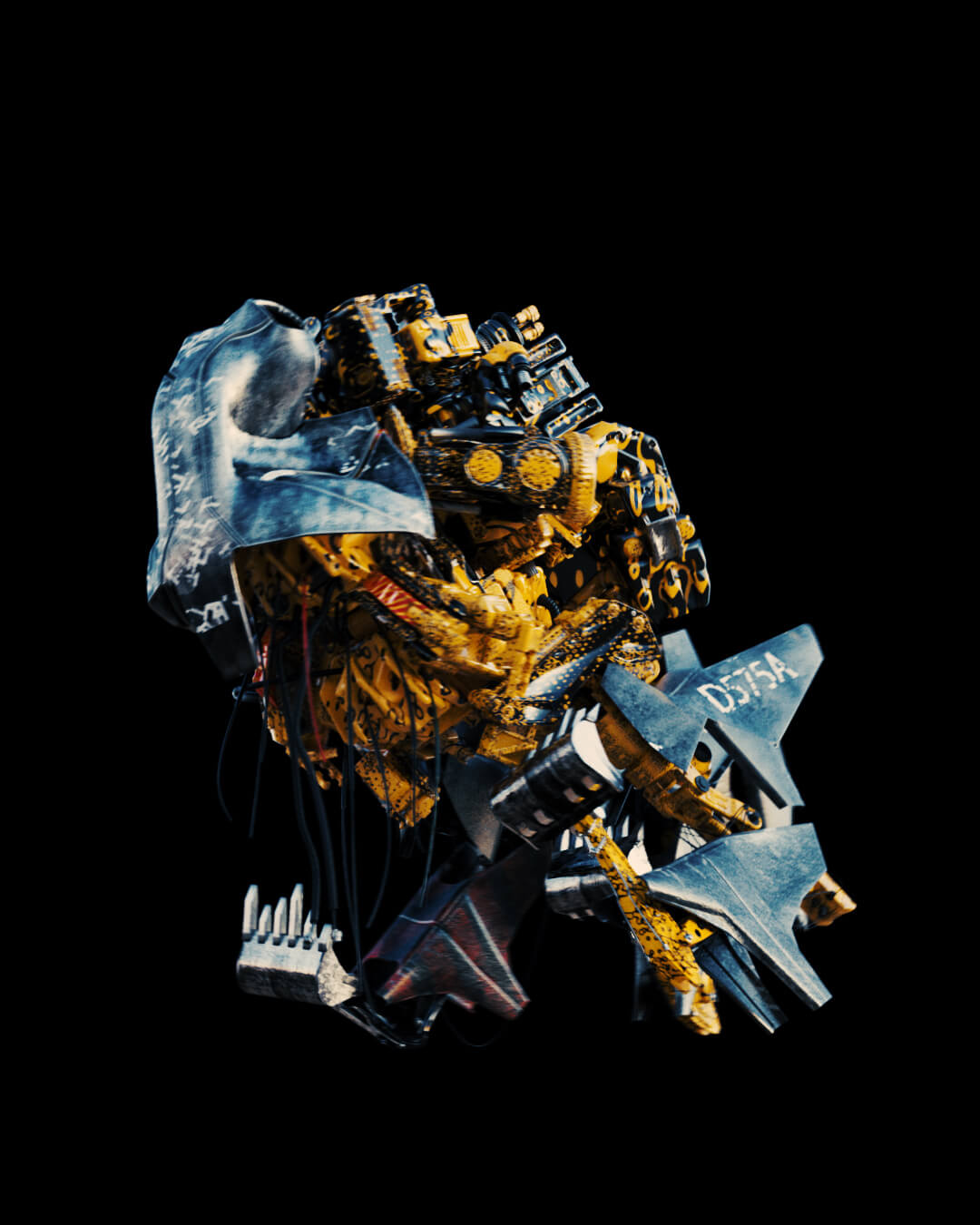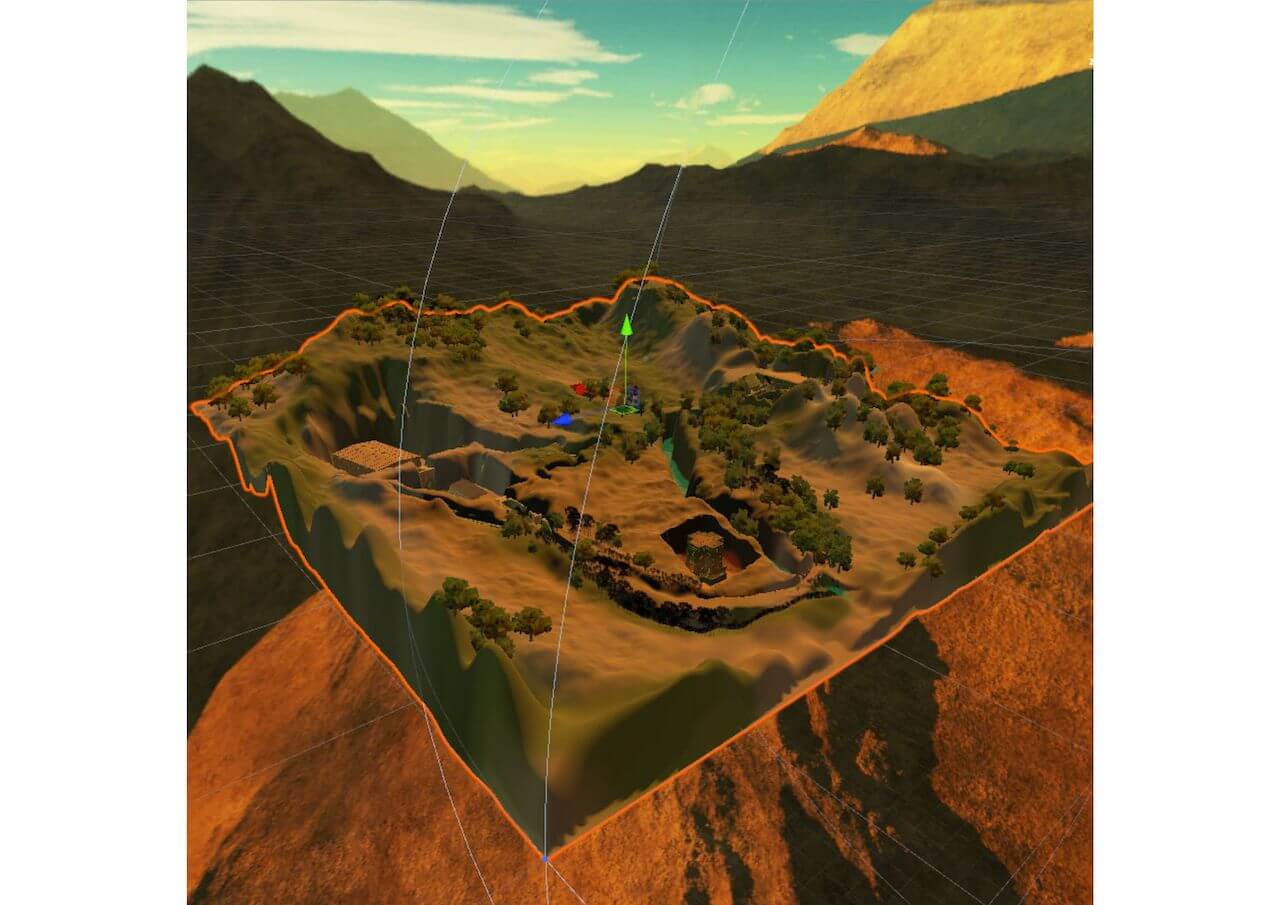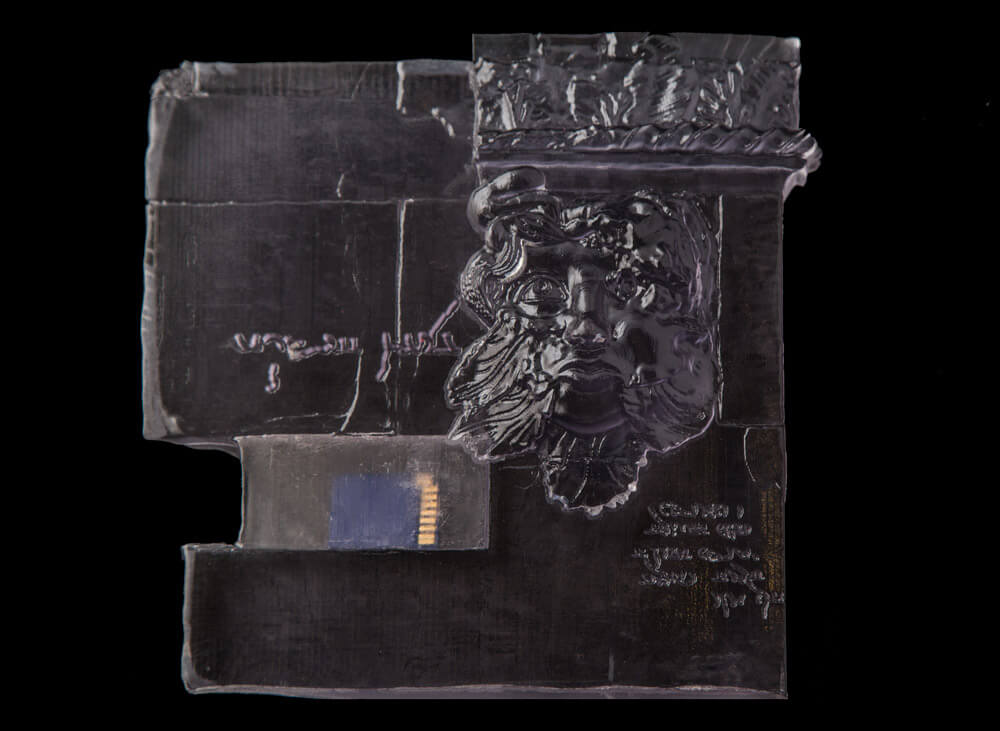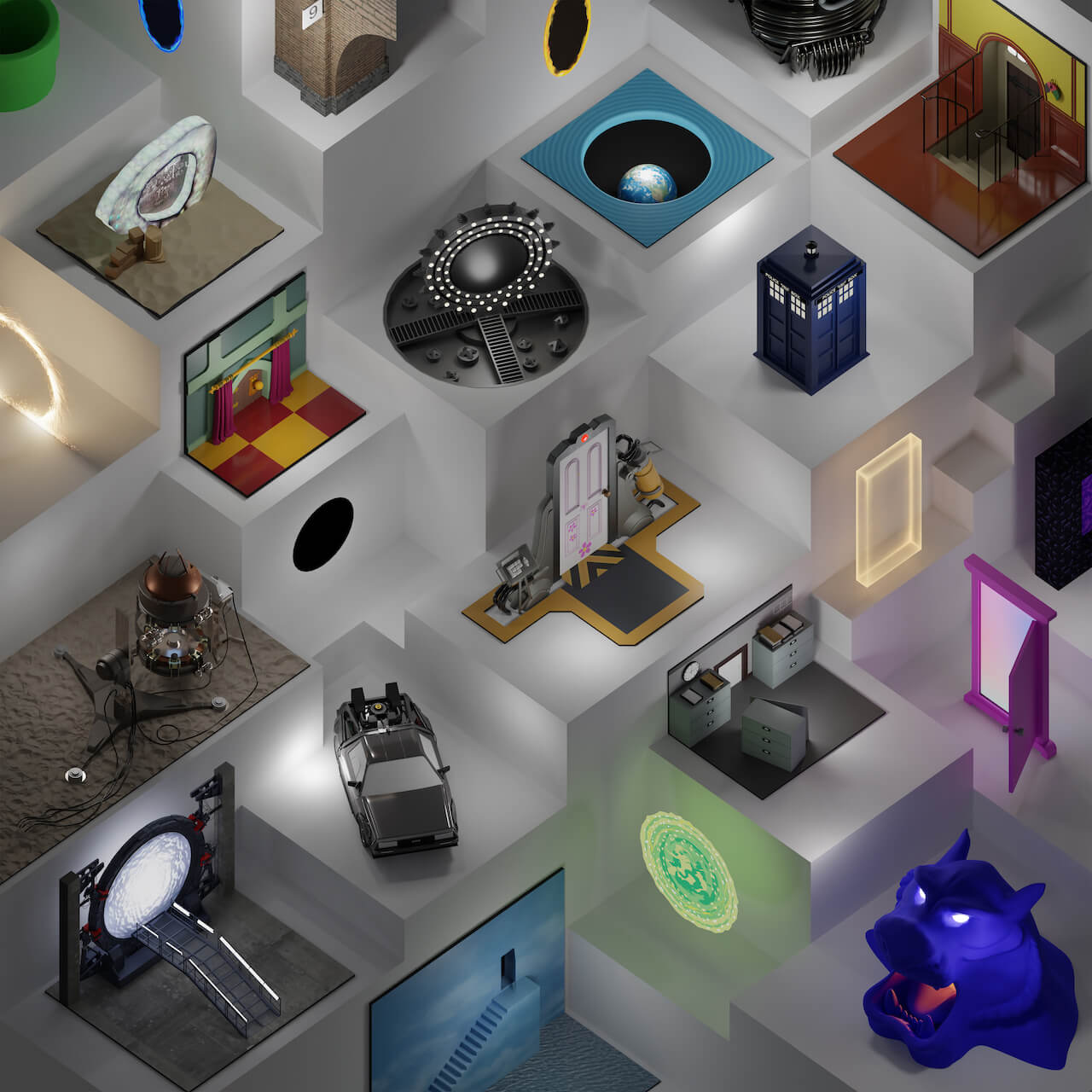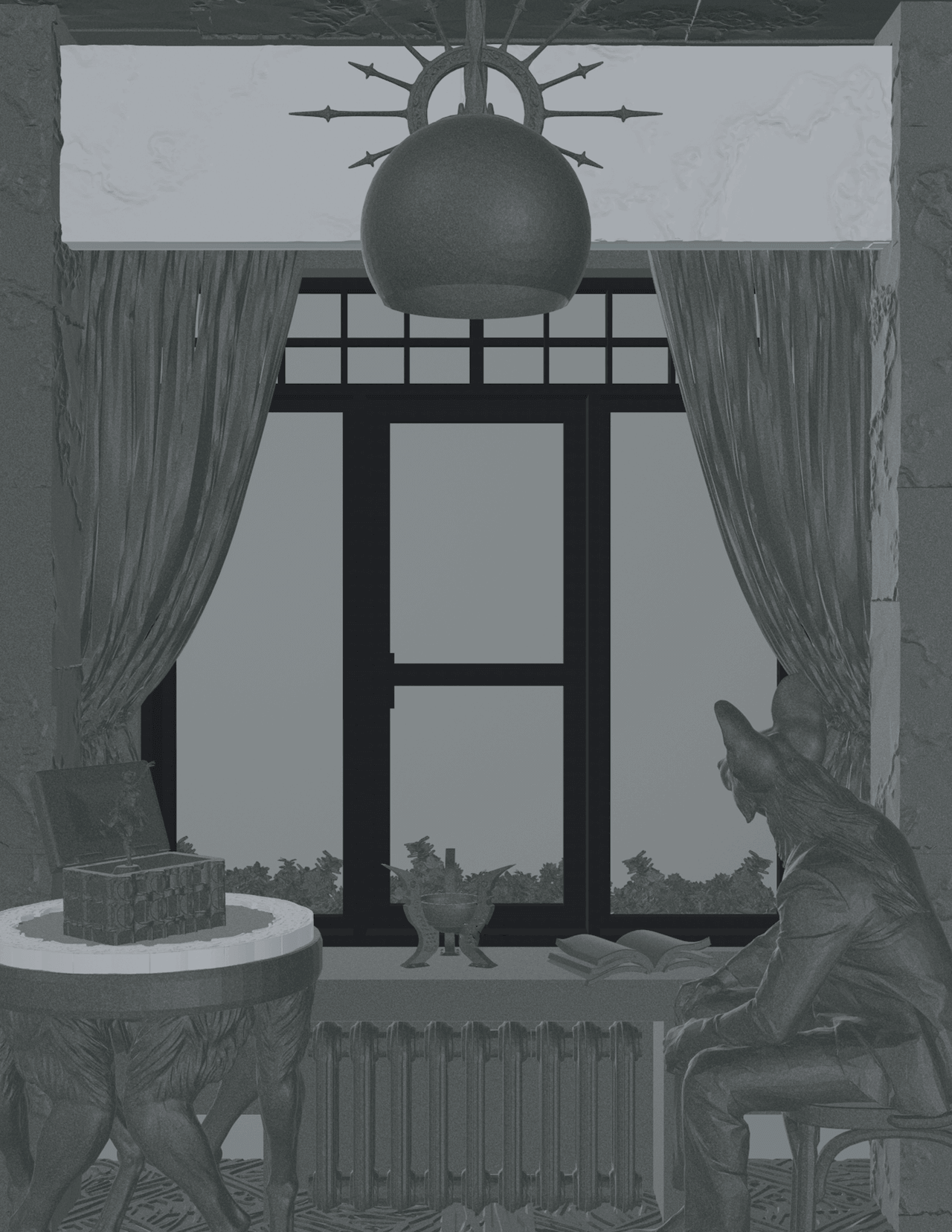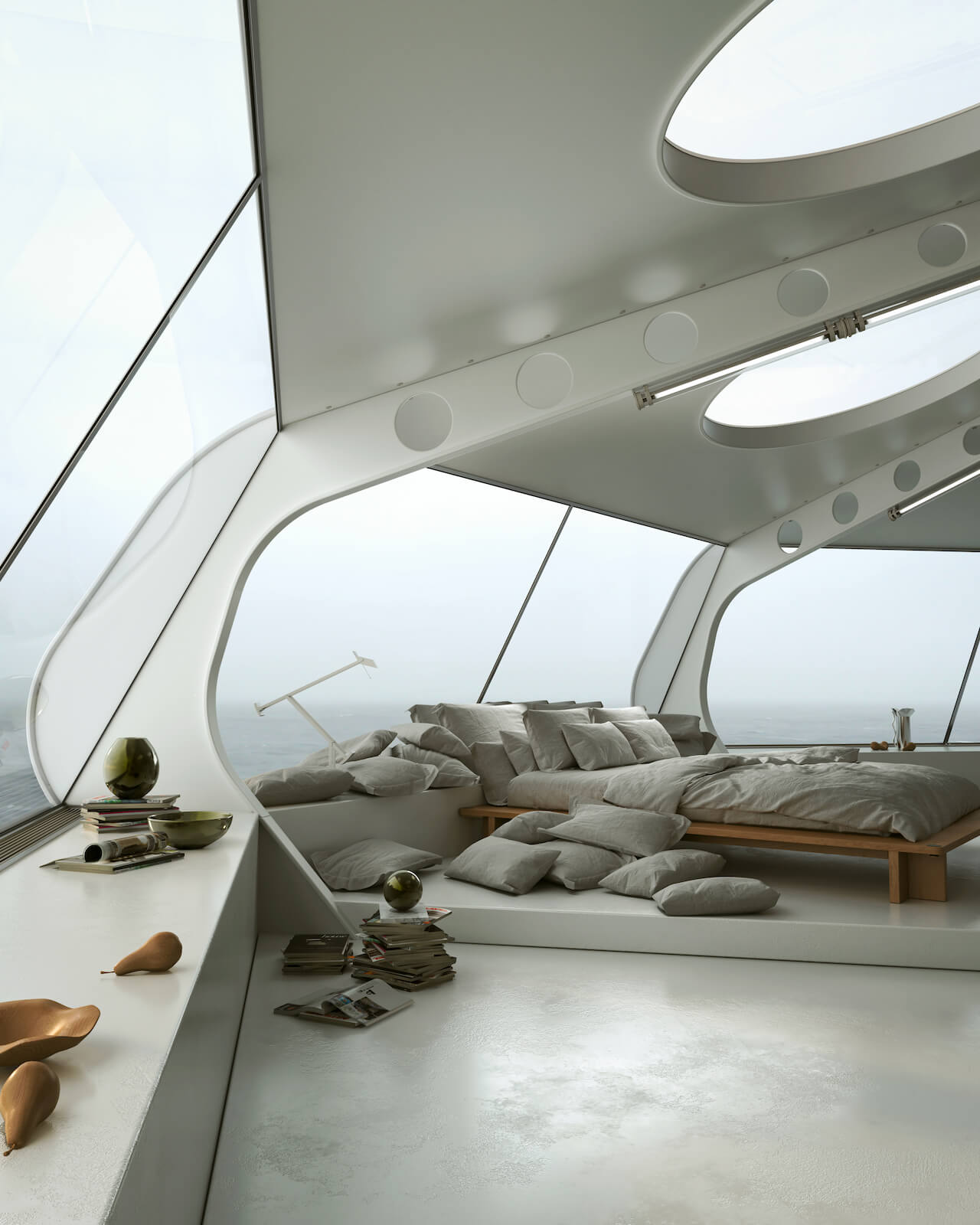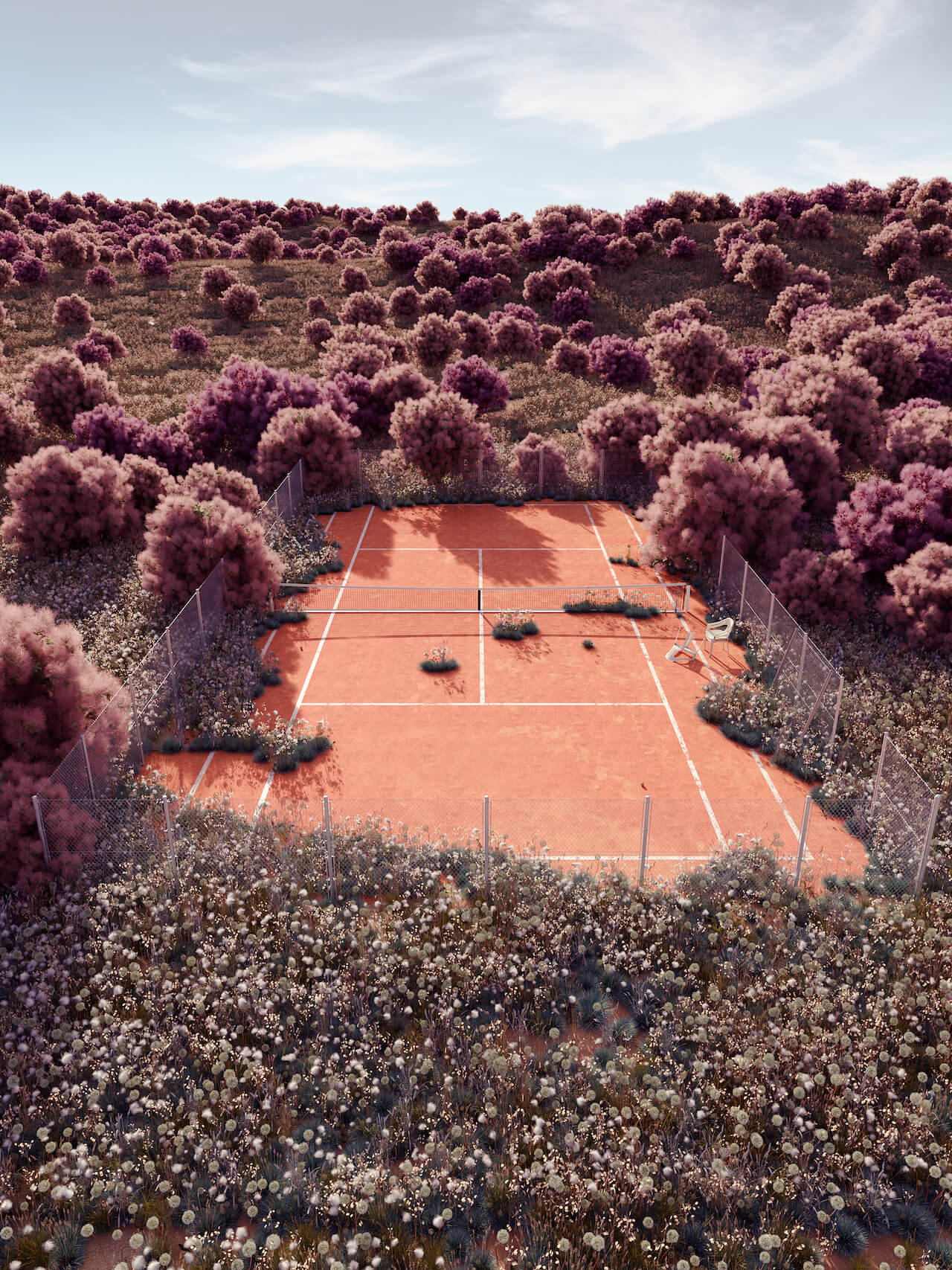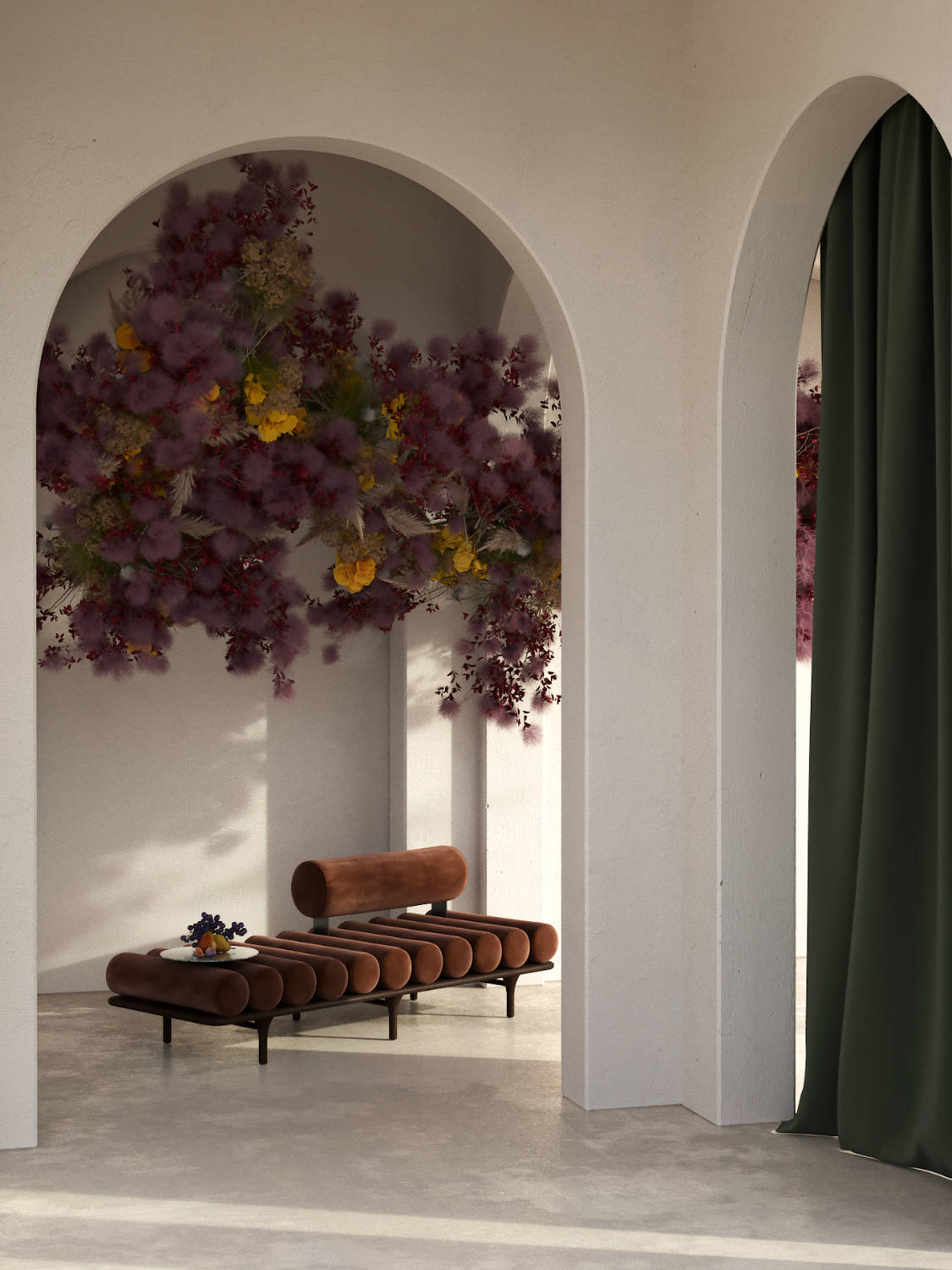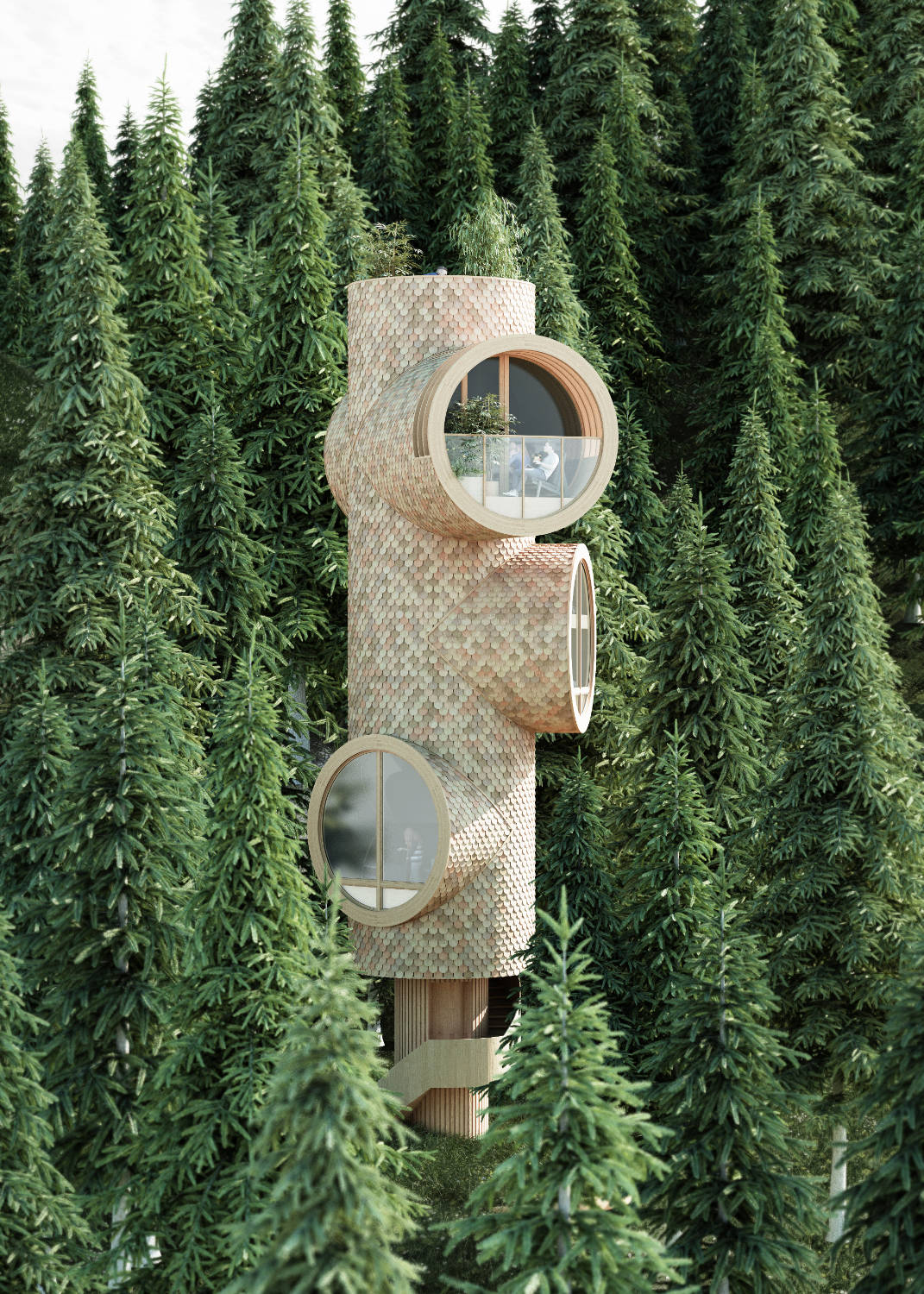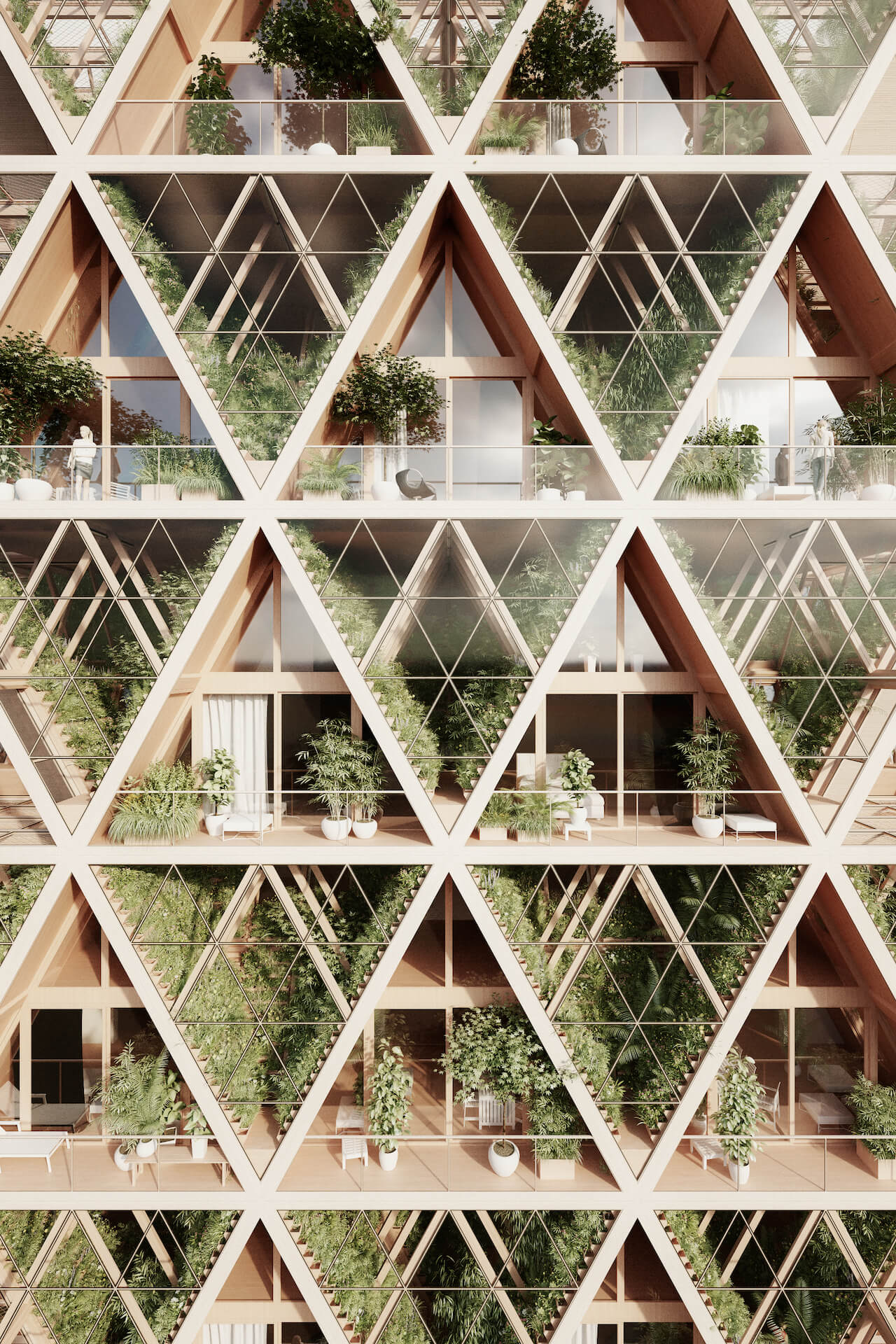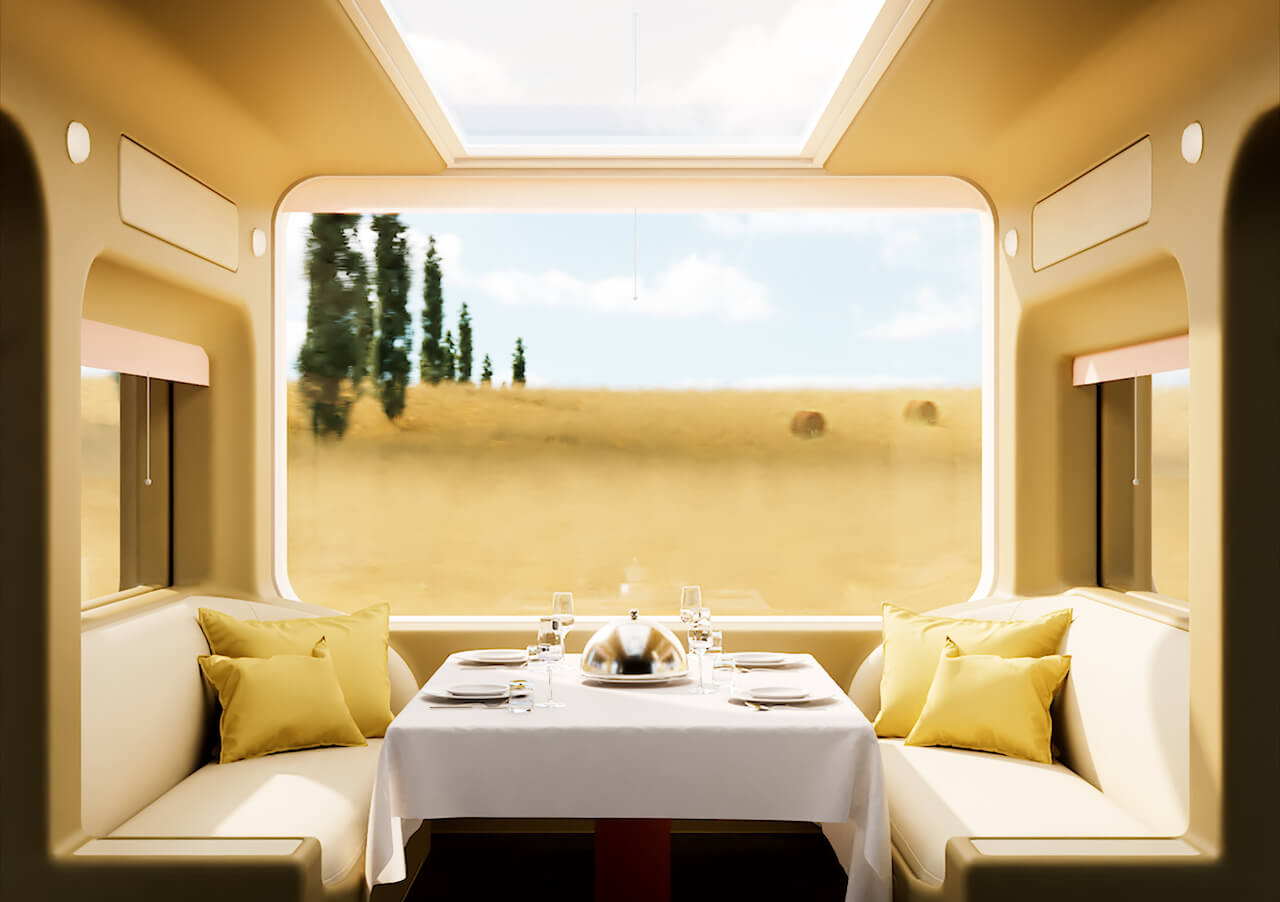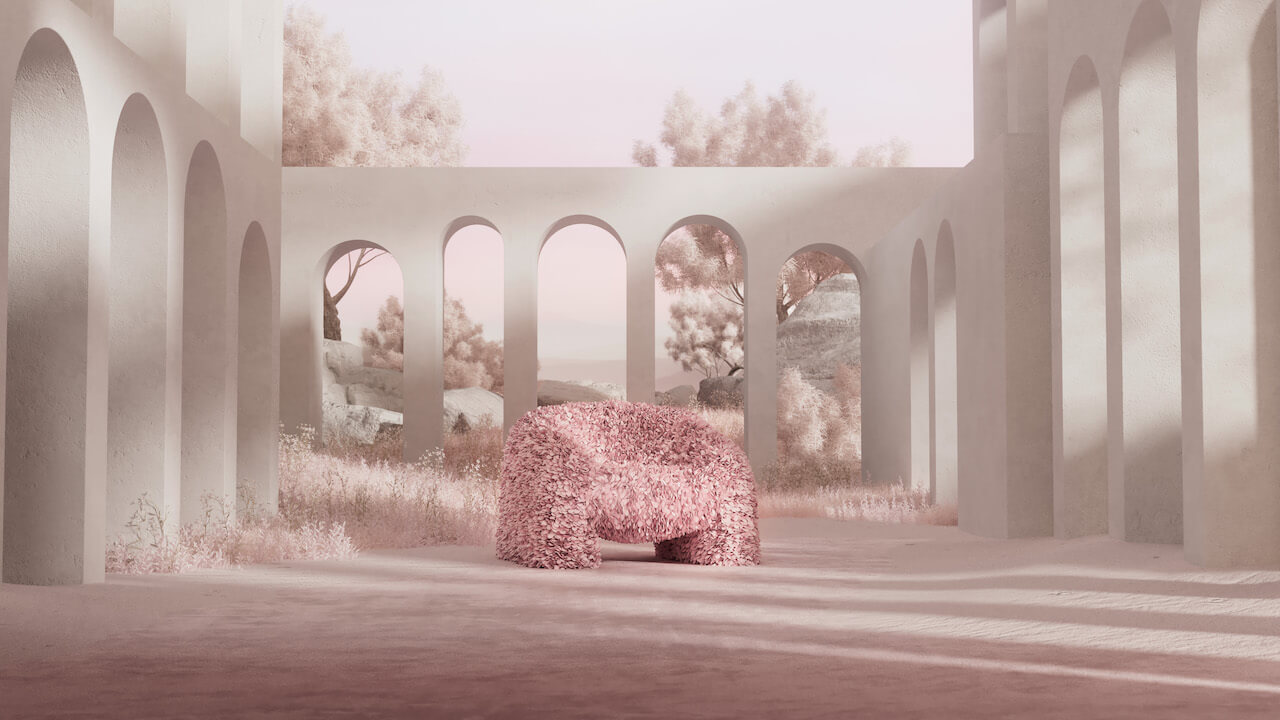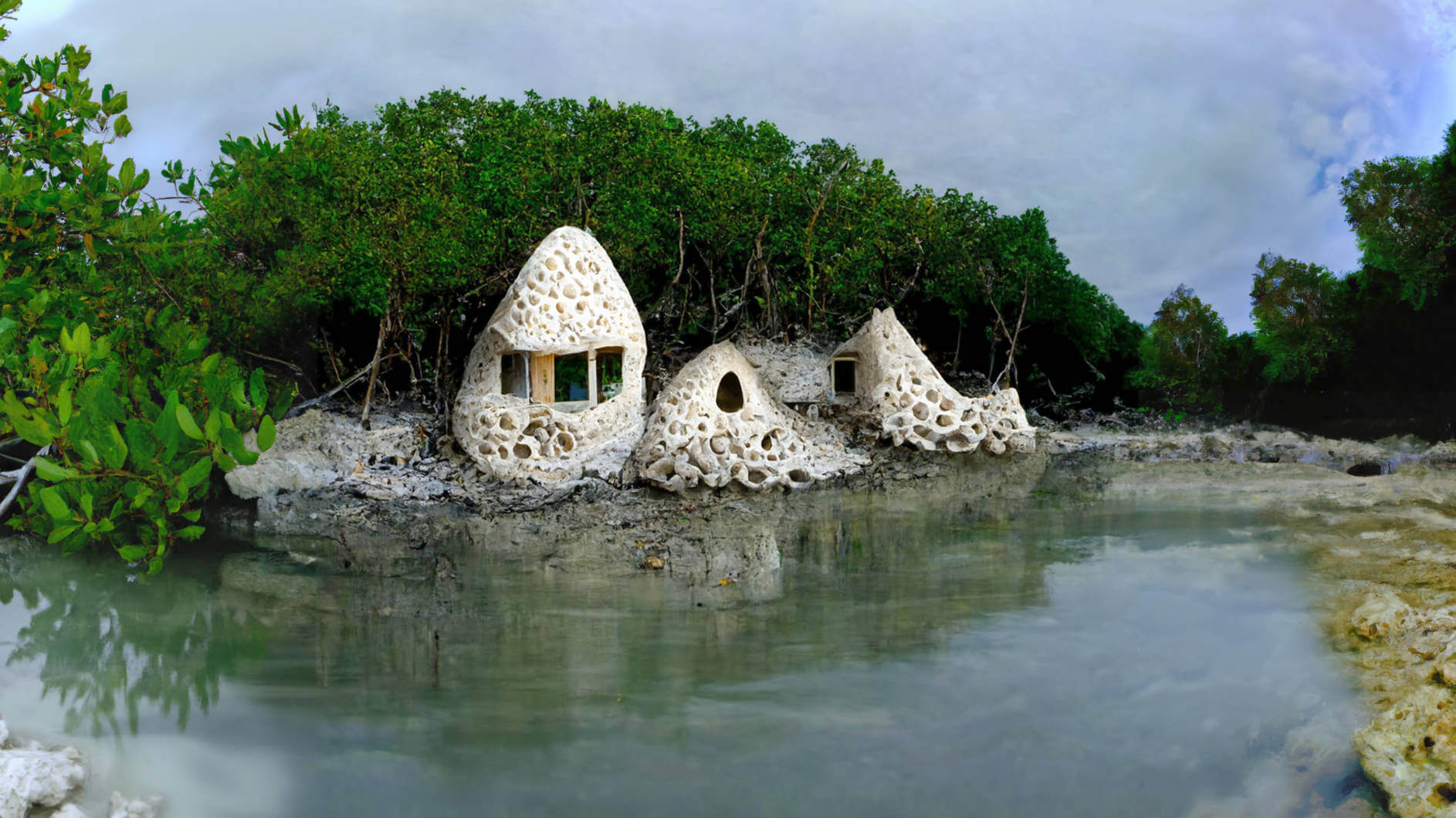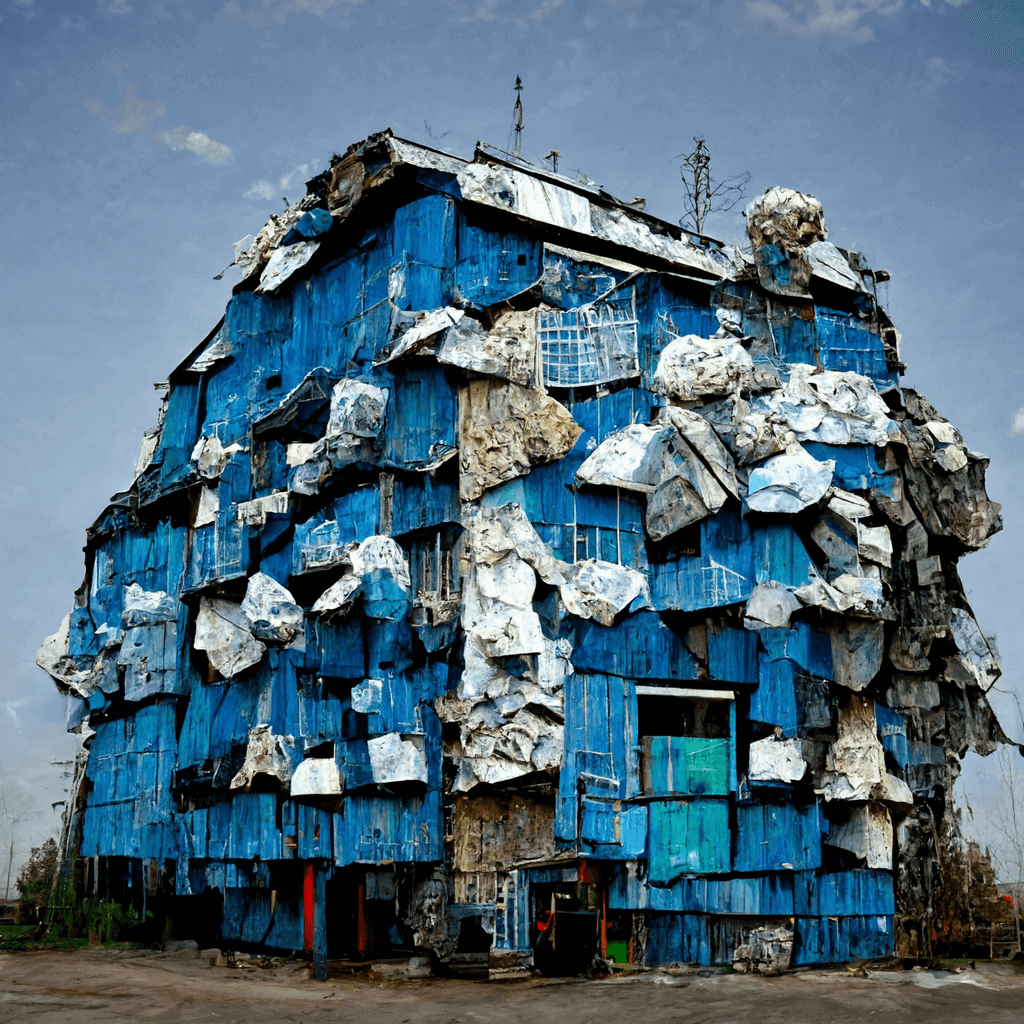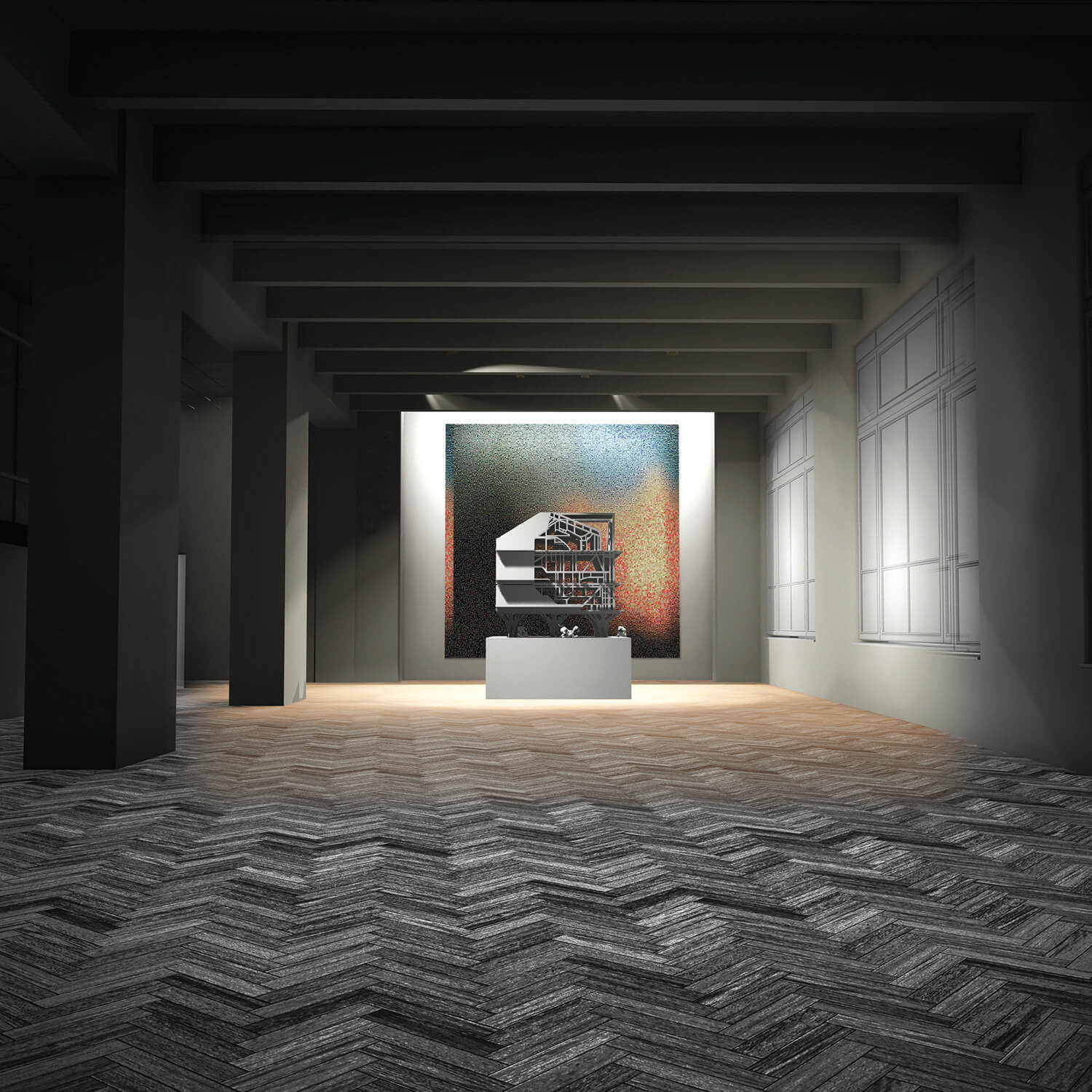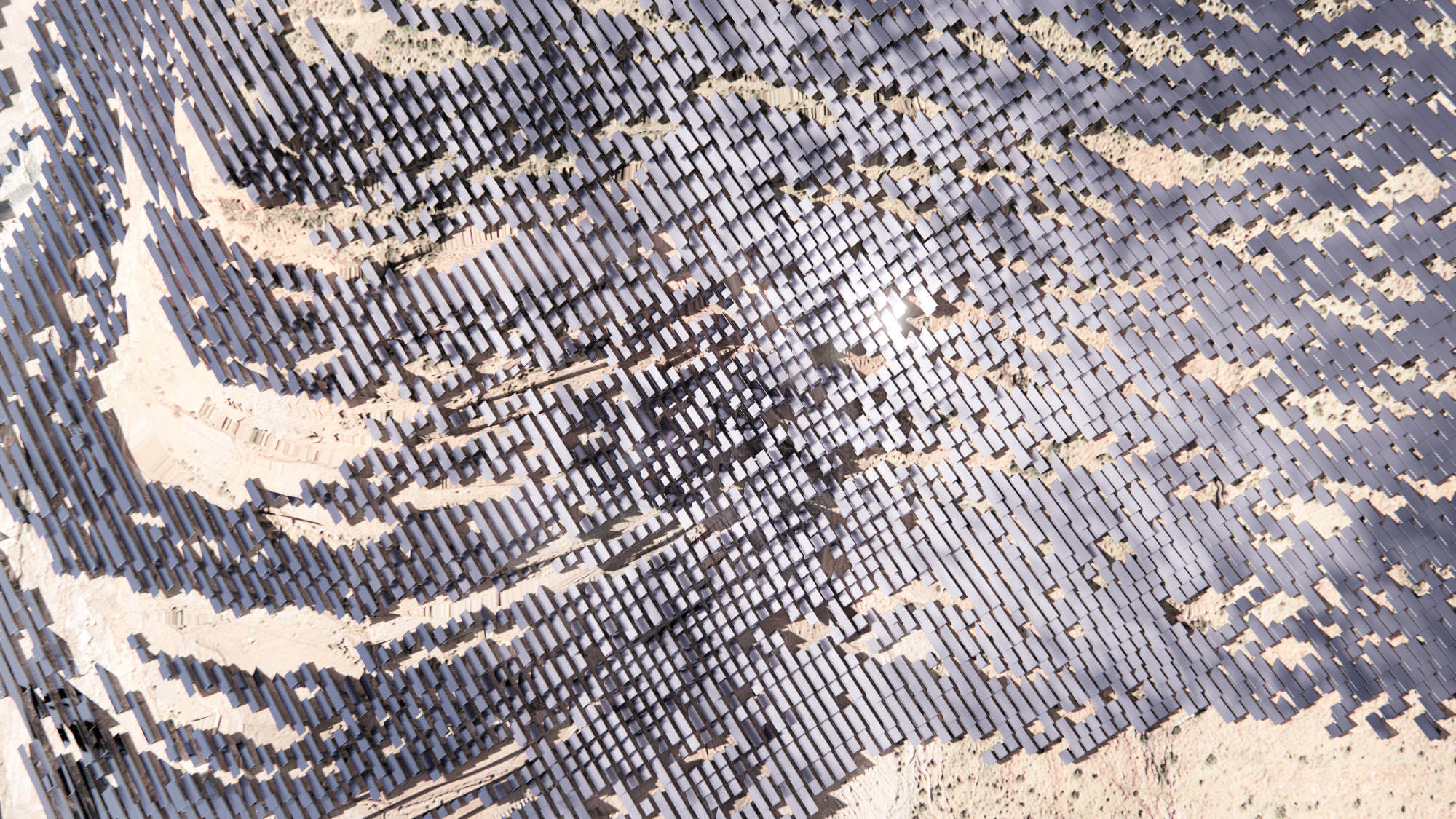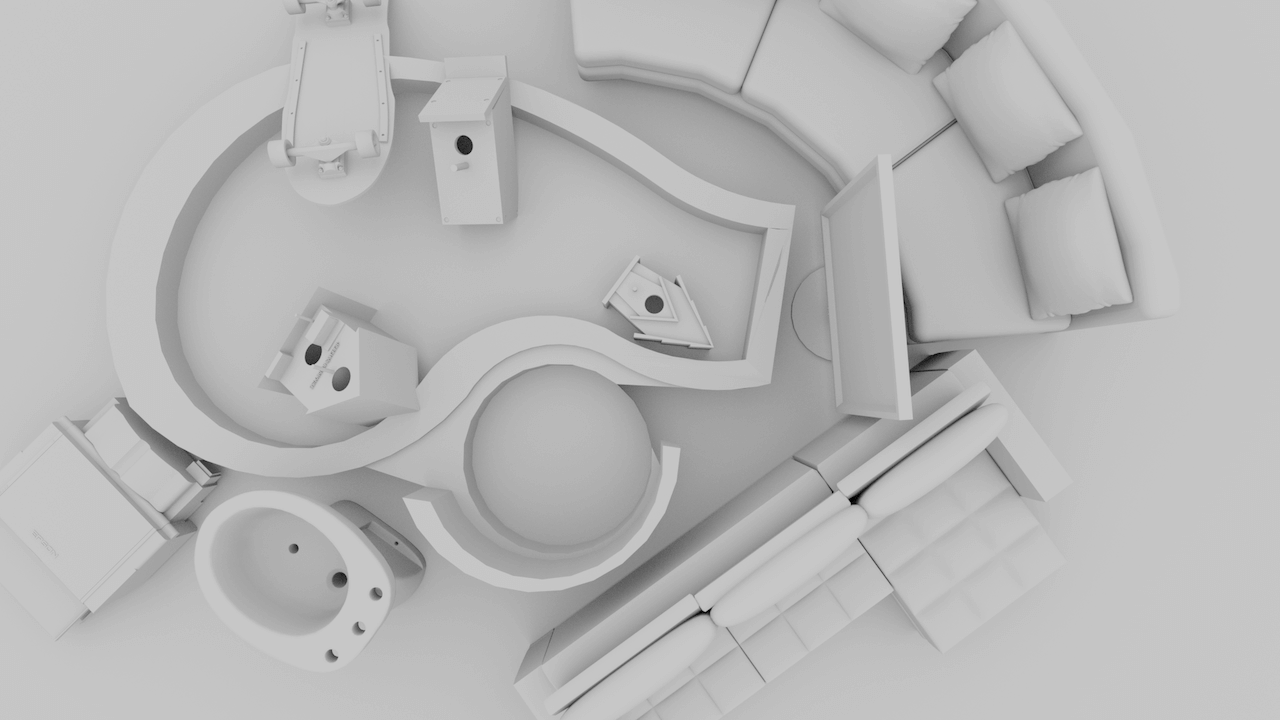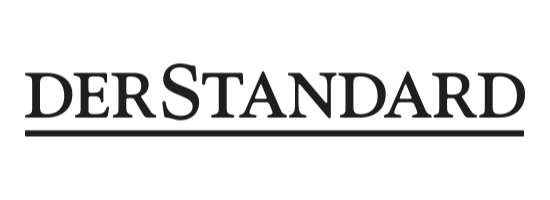The New Virtual
In virtual space, visionary designs and fictional scenarios for architecture and urban planning can be imagined and distributed beyond the limitations of the real world. Computational tools that are now widely accessible and the socio-technical aspects of Internet use have not only revolutionized the creative process and concept development in architecture and design, but have expanded our understanding of how we shape, experience, and navigate space.
/imagine: A Journey into The New Virtual brings together projects from a new generation of imaginative creators, from a range of backgrounds and disciplines, including architecture, landscape design, interior and product design, urban planning, visual arts, game design, and film. Together, they represent a distinct and recent manifestation of The New Virtual that deals with the challenges and potentials of virtual worlds, as well as the associated social, ecological, political, and infrastructural effects.
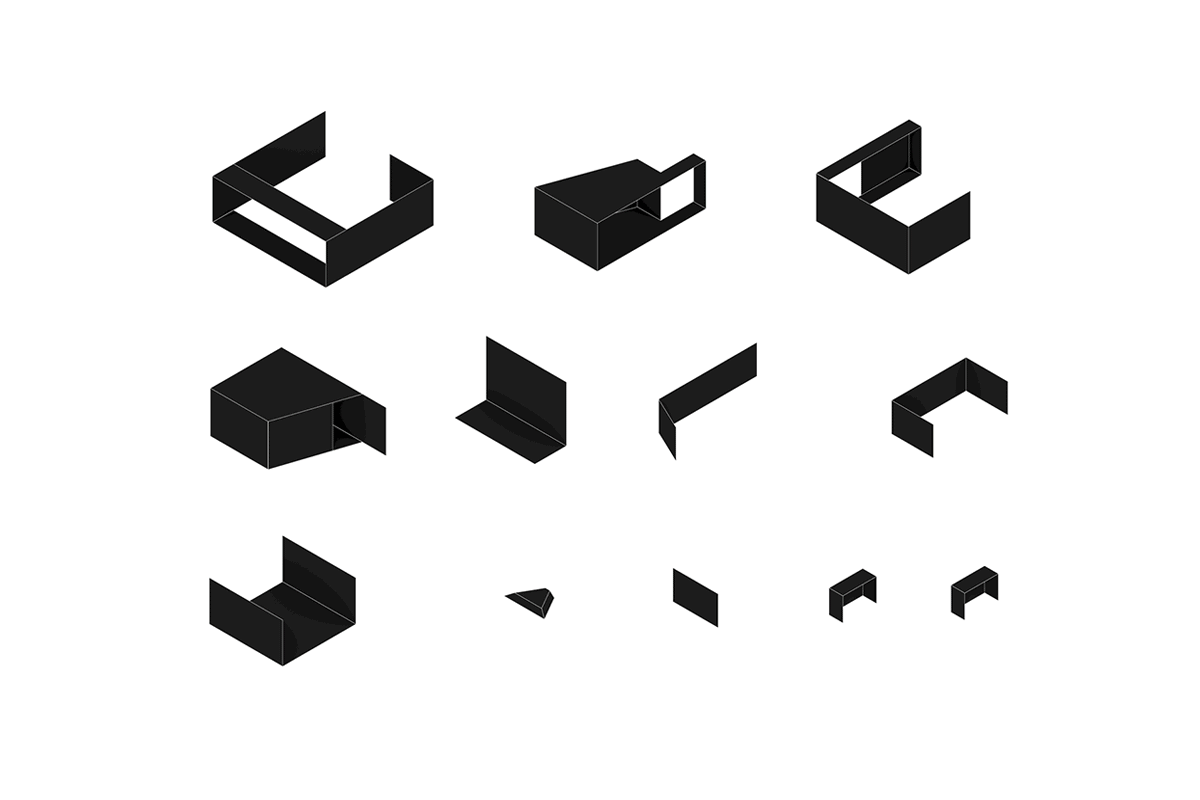
Exhibition design animation
© Some Place Studio
While not exhaustive, the exhibition aims to present a freeze-frame in the constant evolution of the design of virtual space. Looking at the last decade (2013–2023),it features critical, interactive, participatory, playable, and hyper-realistic works from younger generations in a variety of media, such as renderings, CGI visualizations, 3D animations and prints, digital films, and virtual reality, as well as blockchain projects and video games. Several newly commissioned and recent works are being shown for the first time in a museum. Structured into four overlapping sections, the exhibition presents common threads within The New Virtual.
By envisioning new ways of building and designing in virtual space that may not yet be feasible or realistic, the projects presented in this exhibition push the boundaries of the built environment, creating new narratives, perspectives, and agency in virtual space that may continue into physical reality.
/imagine: is the command that allows users to create their own architectural utopias with the software Midjourney. Based on a text prompt, an AI algorithm generates images that can be varied infinitely.
Speculative Narratives and Worldbuilding
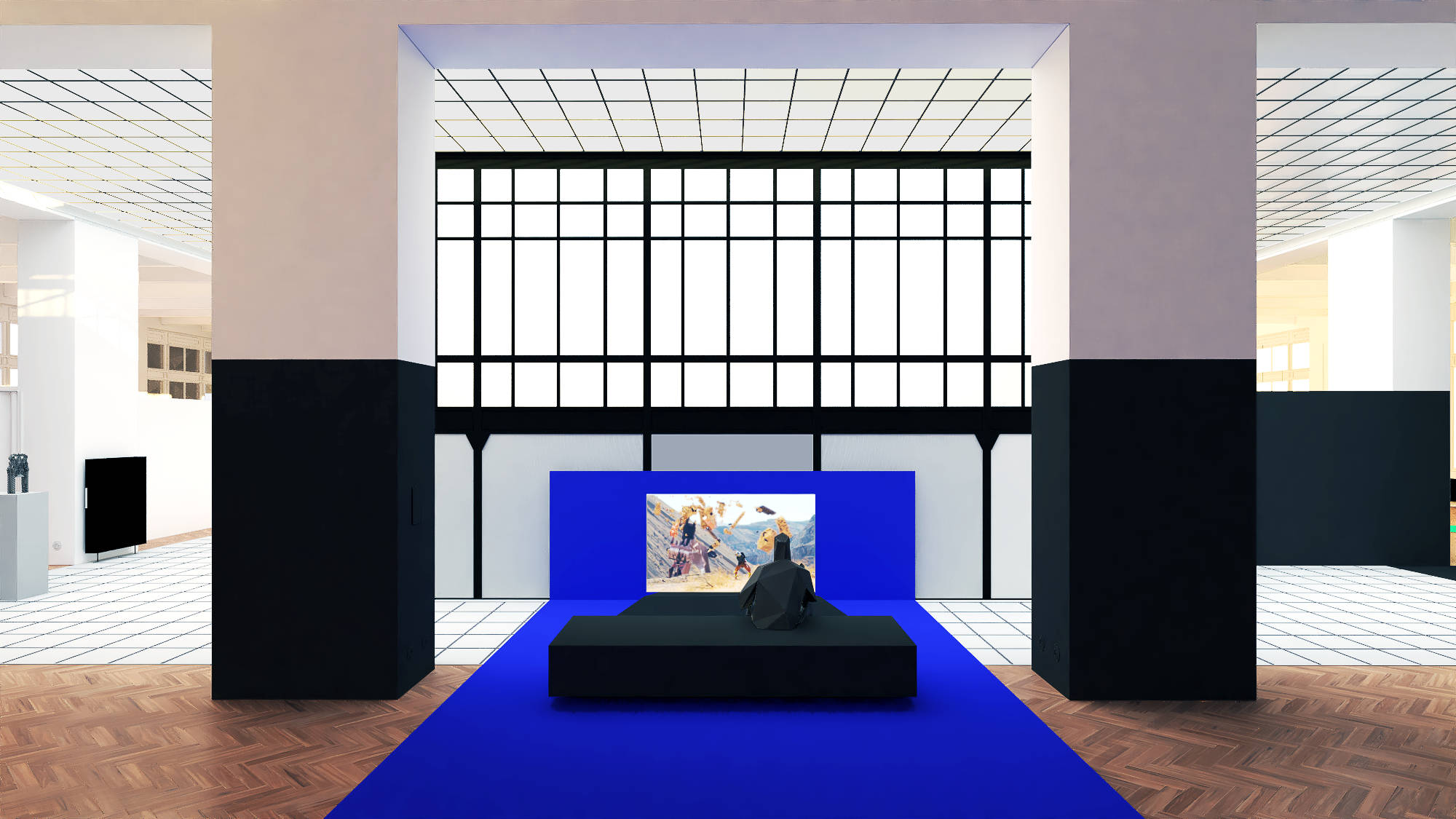
Exhibition view at the MAK, Vienna
© Some Place Studio
Storytelling is an intuitive way for humans to understand and make sense of the world. Computational tools such as rendering, 3D modeling, and animation are enabling the creation of complex narratives and fictional worlds.
The projects gathered in this section are grand in scope, speculating on future scenarios through terraforming, city building, or rewilding. Taking inspiration from science fiction, gaming, and movies, their goal is not to create blueprints for the future, but rather to play with the imagination, envisioning new scenarios of coexistence on a planetary scale. While expansive in their themes, the works take care to center the audience using formats such as first-person perspective, interactive gameplay, and virtual reality immersion.
The assembled architects and artists have developed scenarios that are neither utopian nor dystopian, but rather offer inspiration and ideas for future communities. Using Web-3 and blockchain technologies, and multiplayer game environments, they explore methods for collective decision-making and engaging with the commons.
While the modernist tradition of architectural representation tends towards reduction and abstraction (such as black-and-white drawings of a building in plan or section), the projects shown here work with emotional, ambiguous, and interactive means. To achieve this, they use specifically developed software and working methods from the film and gaming industries.
In a time when much of futurist thinking and "imagineering" has been taken over by international corporations (Big Tech), it is ever more important for architects and designers to visualize and (re)present their critical, provocative and evocative visions of what the future could hold.
Research Investigations
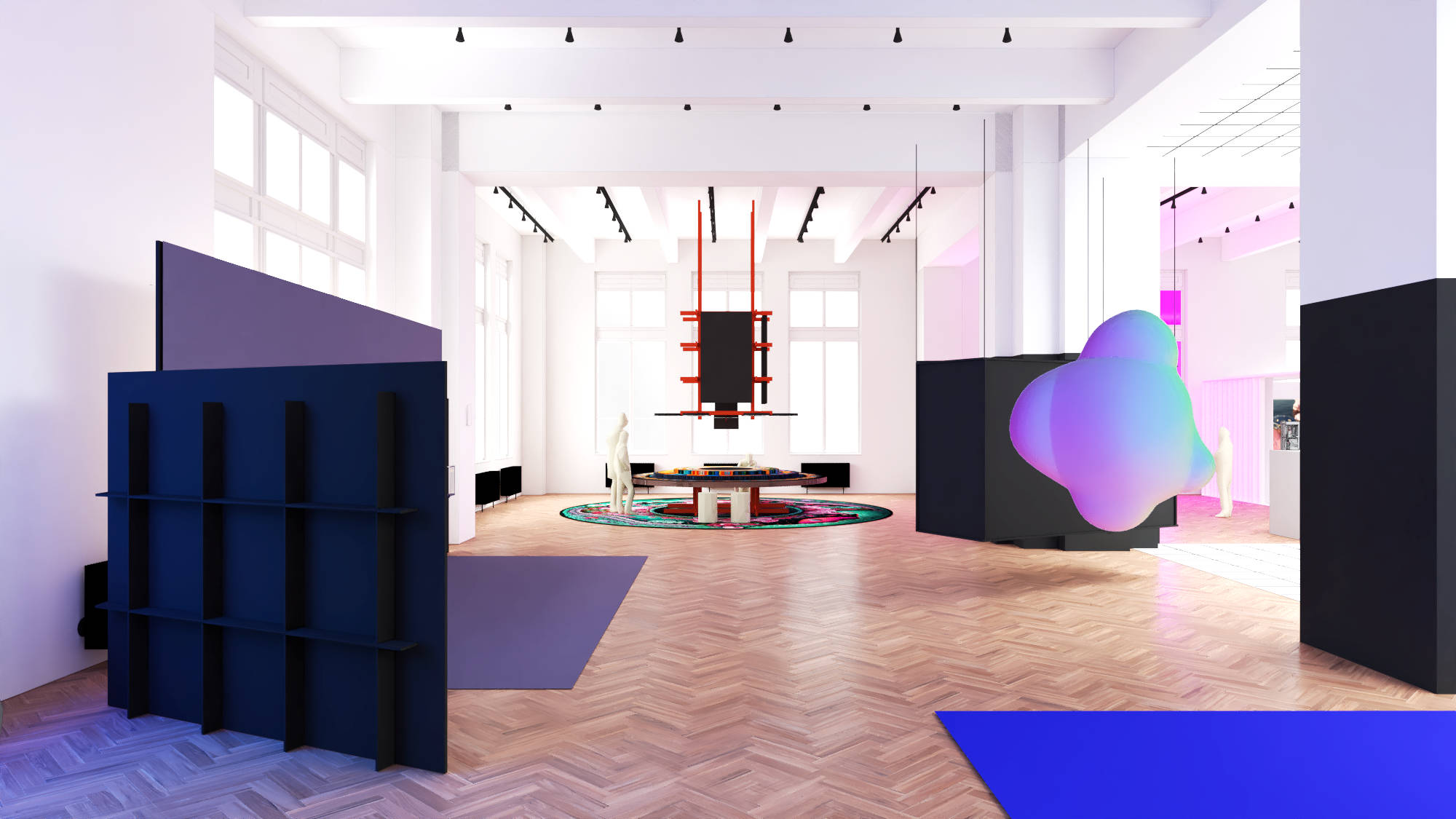
Exhibition view at the MAK, Vienna
© Some Place Studio
3D scanning and modeling allow sculptures, buildings, or entire landscapes to be recreated in virtual space and used for research. However, existing copyright laws do not regulate the use of 3D models to the same extent as photography or film, raising pertinent questions about authenticity and ownership.
3D printing is the reverse process of turning digital models back into physical objects. It allows to recreate lost or destroyed artifacts or to merge figures and objects with different meanings and heritage into new combinations.
Just as Western museums integrate global artifacts into their collections, large corporations are collecting the world's digital data, including "digital twins" of physical sites and objects. Although often presented as generous and open source, the documentation of global cultural heritage by predominantly Western companies and initiatives is instead a de facto reiteration of Western colonial attitudes towards ownership of cultural artifacts.
This section of the exhibition features projects that challenge these attitudes and provide insight into the emotional and poetic qualities of digital objects. They open up counter-narratives to the ongoing influence of Western technological colonialism and focus our view on the necessary decolonization of digital data.
These questions extend to virtual worlds, or the so-called metaverse, which currently consists of self-contained environments owned by private companies. Architects are thinking about civic organizational structures that enable interoperability between systems, creating new ways of navigating virtual space. These ideas are as much about design as about defining who owns these spaces, who they are for, and how they are regulated.
Architects, designers, and artists are using a range of digital technologies to find new ways of combining research and artistic practice, leading to intersectional and interdisciplinary projects that raise profound questions about society and its relationship to technology.
Dreamscapes
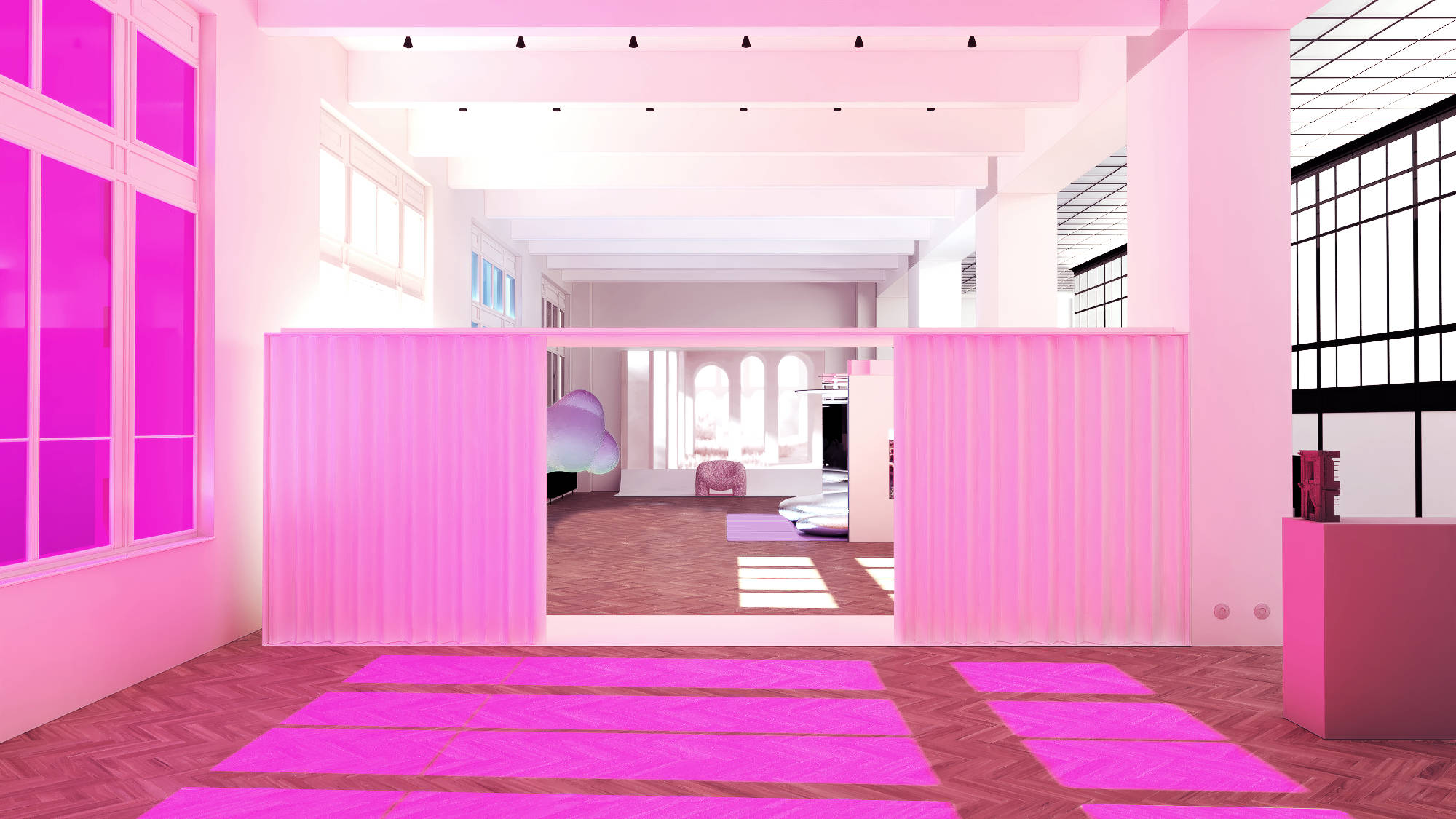
Exhibition view at the MAK, Vienna
© Some Place Studio
The emergence of 3D modeling software has given architects a tool to render the world as they would like it to be, while advancements in technology have made these images more realistic as well as, faster and cheaper to produce. A new generation of creators has embraced the potential of rendering -software, formulating a distinct aesthetic of computer-generated fictional architecture that blurs the boundaries of reality and fantasy.
The Dreamscapes section of the exhibition takes us on a journey to sublime places of longing. The utopian landscapes, buildings, and interiors often incorporate surrealist elements and draw inspiration from the visual vocabulary of modern and postmodern architecture as well as architectural icons such as Luis Barragán, Lina Bo Bardi, Ricardo Bofill, and John Lautner.
Historically, "paper architecture" has been associated with nonviable designs, but it has also been used as a form of resistance against functional and homogenous architecture. During economic downturns and the Covid-19 lockdowns, this concept saw a resurgence, giving rise to a new aesthetic movement of utopian rendering designs.
These virtual spaces are designed with minimalist forms, pastel colors, and soft lighting, exuding a sense of calm and luxury, and offering serenity and escapism in times of unrest and crisis. They often feature opulent visuals and uncluttered, uninhabited surroundings that incorporate mere hints of human activity—a rumpled bedspread, an open magazine, or a half-empty glass—thus allowing viewers to project themselves into these spaces of desire. Incorporating lush plants and flowers, they often allude to modern architecture's play with in- and outdoor space, while questioning our anthropocentric relationship with nature.
The creators of these dreamscapes come from a variety of backgrounds and disciplines, including product, interior, and landscape design, as well as architecture and fine art. Many collaborate with each other or with rendering studios to co-create projects, e.g., for international brands. Some are now building their designs in the metaverse or the physical world.
Social media plays a significant role in shaping this movement, expanding the reach of creators through user habits and algorithmic preferences, with their images and videos going viral on Instagram. As minimalist forms provide a perfect raw material, some creators are now using AI algorithms, such as Midjourney, to generate their images. The designs arising from the symbiotic relationship between the dreamscape designers' aesthetic and algorithmic tools lead in perfectly to the next section: AI and Algorithmic Variation.
AI and Algorithmic Variation
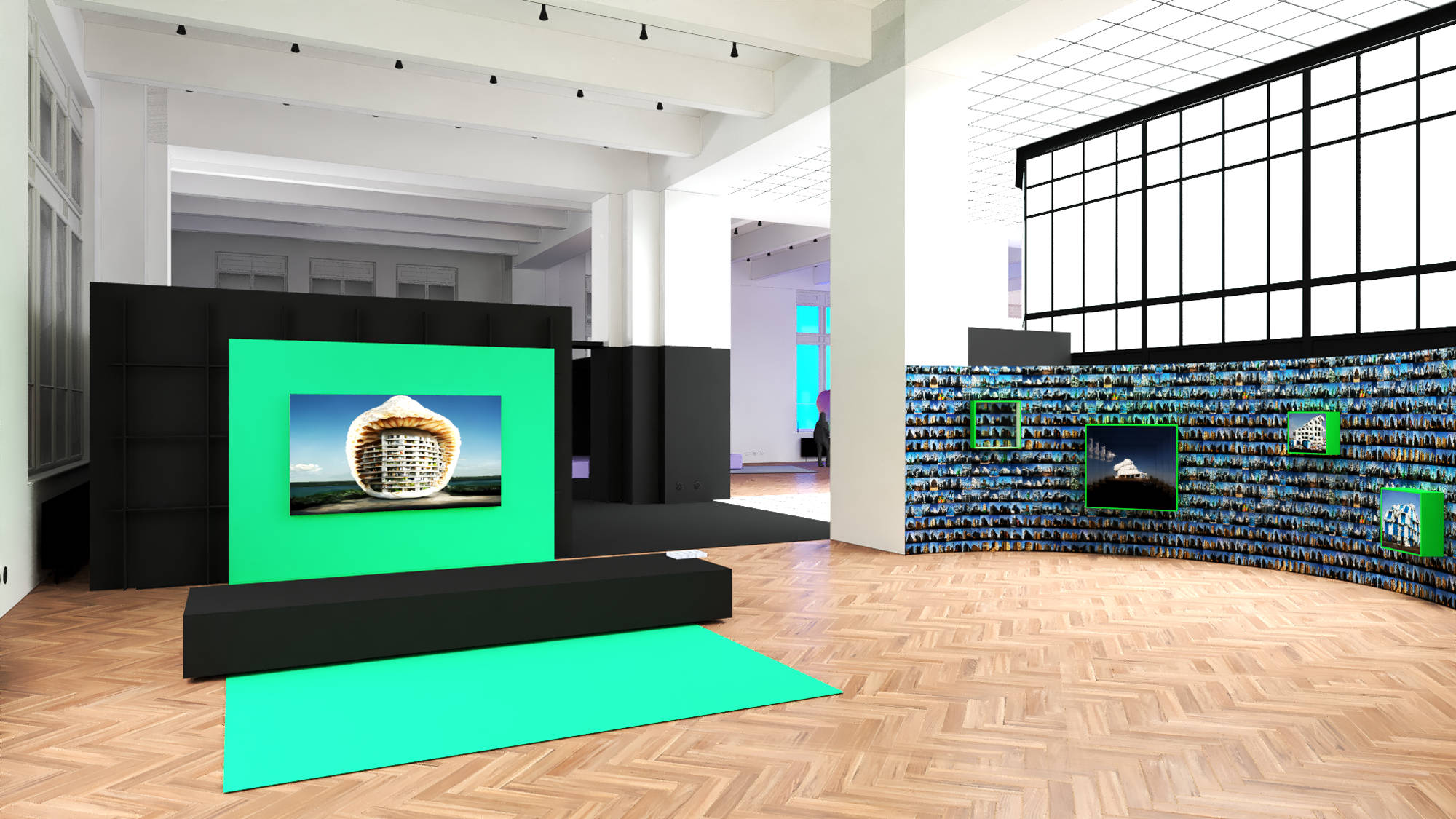
Exhibition view at the MAK, Vienna
© Some Place Studio
The public availability of AI algorithms such as Midjourney, Dall-E, and Stable Diffusion has given rise to a trend for creating fictional architectural imagery that has spread far beyond the industry itself.
The projects shown in this chapter use AI-based software and machine learning algorithms to develop a diverse, critical, and playful approach to complex issues around AI, co-authorship, and resources. These works often adopt an ecological perspective and harness the potential of computational design not only for community building but also to visualize futuristic scenarios for biodiverse and "more-than-human" habitats.
Midjourney is currently one of the most popular AI generators. It is based on text: Users enter the prompt "/imagine:" (from which this exhibition takes its name) followed by a description of what they wish to visualize and the algorithm generates four images in less than a minute, representing different variations of the textual input.
Designers who work with Midjourney spend hundreds of hours refining their prompts and creating more and more detailed variations. But even first-time users can achieve impressive results. The increasingly realistic images make it harder than ever to distinguish between reality and AI-generated fiction.
Architects have been working on research and design projects that use algorithmic design since the 1990s—long before AI imaging tools became popular. Many of these early adopters were driven by techno-optimistic excitement about the opportunities presented by these new technologies.
The basis of algorithmic design is data. The way this data is collected, labeled, and organized informs the results that are generated. The generation of younger practitioners showcased here present a nuanced and multifaceted view of how algorithmic design serves the purposes of those who use it. In the end, the responsibility to use these technologies fairly and ethically lies with humans.
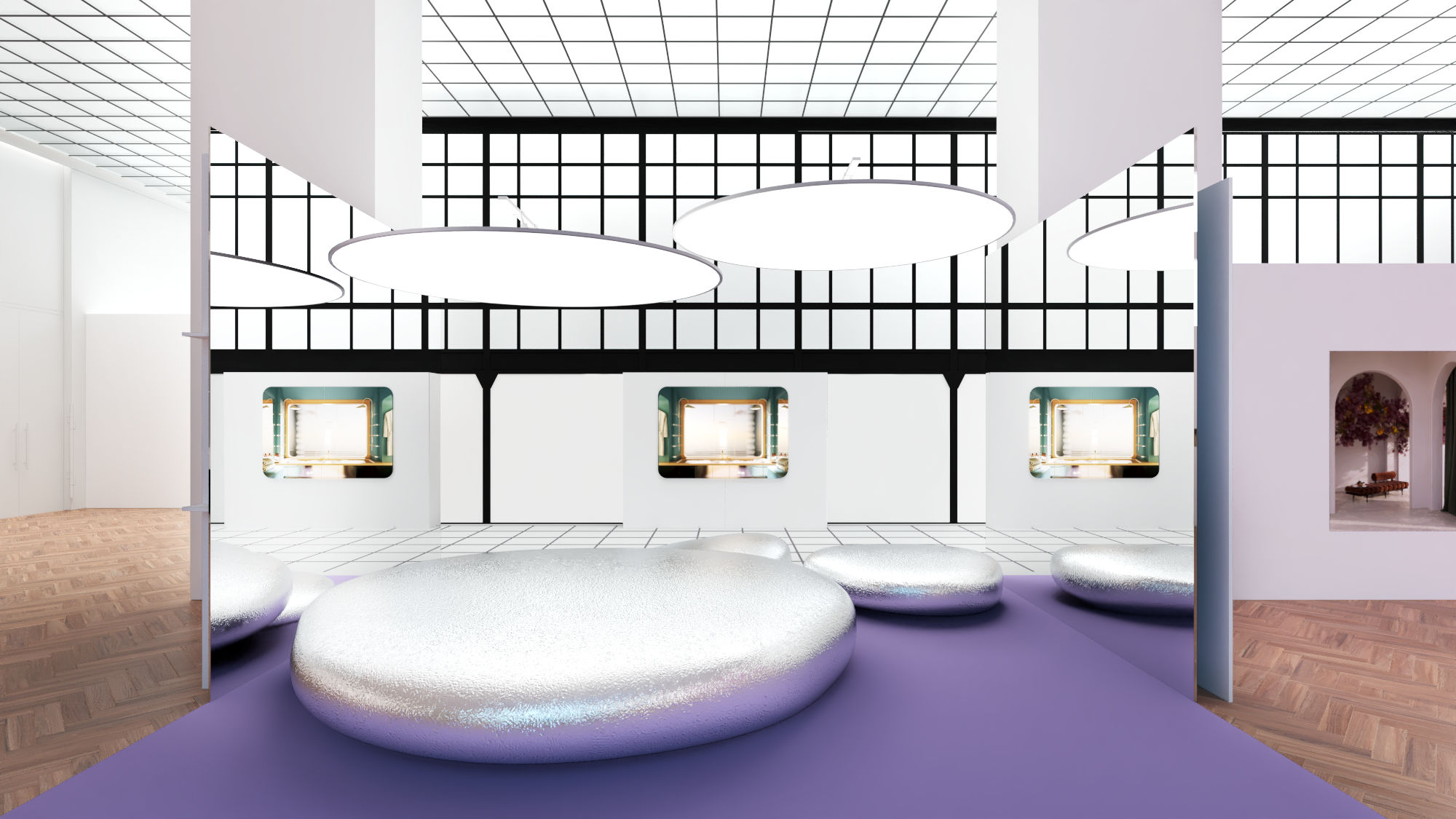
Exhibition view at the MAK, Vienna
© Some Place Studio
/artworks
Liam Young, Planet City, 2020
Film, 15:00 min
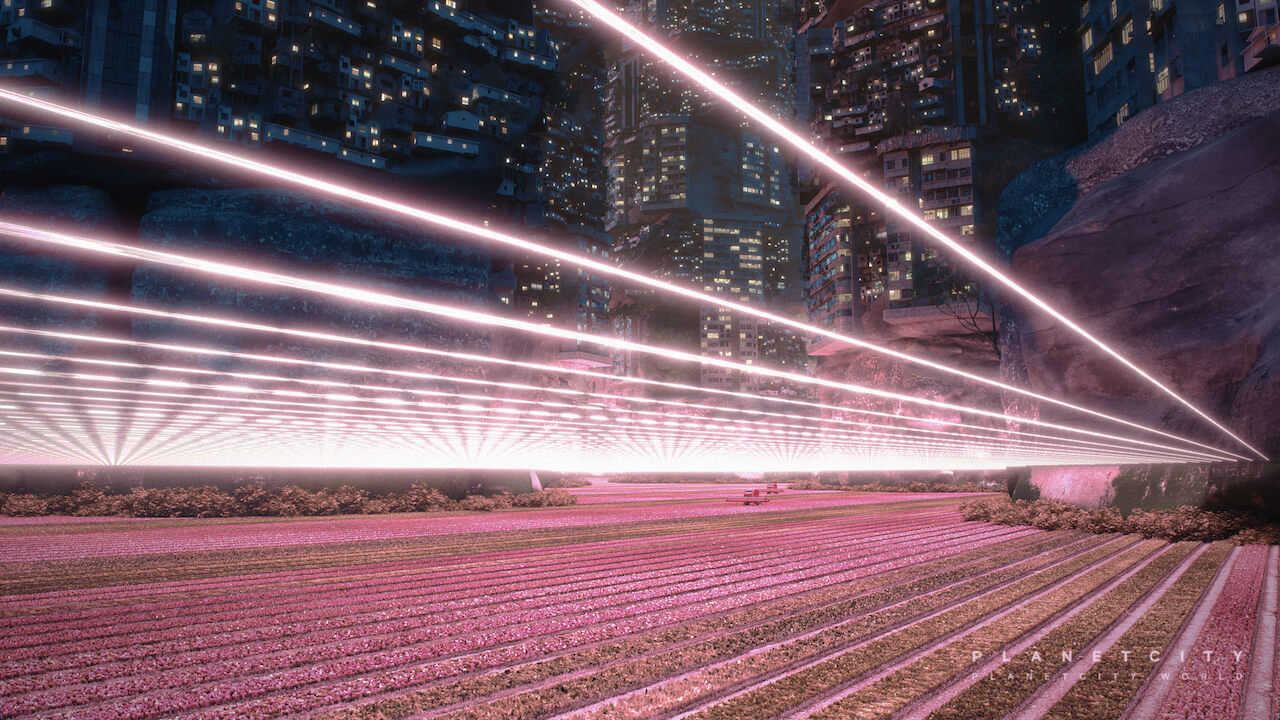
Liam Young, Planet City, 2020
© Liam Young
Film, 15:00 min
This exhibition shows Liam Young's 2020 short film Planet City, a speculative proposal for a city in the year 2050 for the first time in a museum in Austria. The project is based on the premise that the Earth's entire population—10 billion people—live together in a single city, while the rest of the planet's surface is surrendered to a global wilderness for regeneration.
The short film draws on methods from science-fiction film and "worldbuilding" (the creation of a fictional world with all its details) to convey a futuristic architectural idea. Narrative fiction is seen here as a grand act of design that offers the possibility of communicating a provocative idea to a broad audience. To make this post-apocalyptic utopia believable, Liam Young not only designed the architecture and digital environment of the post-apocalyptic metropolis, but each intricate detail of how this city might look, function, and feel: from food and energy supplies to greenhouses, algae farms, and gigantic solar plants, the different residential areas, their culture and social habits, as well as the clothing and costumes worn by the various inhabitants and occupational groups, such as algae divers, beekeepers, drone shepherds, nomadic workers, and zero-waste weavers.
At the same time, Planet City refrains from the techno-utopian fantasy of creating a new world order. It is not a neocolonial master plan, but a speculative fiction of critical architecture based on statistical analysis, climate science, and traditional knowledge.
The project is a perceptive commentary on the devastating effects of colonization, globalization, and the continued extraction of resources. It makes a powerful case that climate change is not only a technological or architectural problem, but rather an ideological one rooted in culture and politics.
Described by the BBC as "[t]he man designing our futures," Liam Young is a Los Angeles-based speculative architect and film director. In his multi-nominated and award-winning films, he brings together extraordinary images of tomorrow and urgent explorations of the environmental issues we face today.
Jose Sanchez (Plethora Project), Common'hood, 2022
Jose Sanchez (Plethora Project), Block'hood, 2017
iheartblob, _Spaces, 2020
2MVD (Damjan Minovski, Valerie Messini), Rift, Aerial Rocks, Eddy, 2023
Kordae Jatafa Henry, Earth Mother, Sky Father, 2019
Miriam Hillawi Abraham, Abyssinian Cyber Vernaculus, 2019
Morehshin Allahyari, Material Speculation: ISIS, 2015/2016
Space Popular, The Portal Galleries, 2022
Genevieve Goffman, The View, 2023
ZYVA Studio × Charlotte Taylor, Neo-Chemosphere, 2021
Studio Mary Lennox, Charlotte Taylor, formundrausch, Smokebush Court, 2020
formundrausch, No Use For A Name - Daydreamers, 2020
Studio Precht, Bert, 2018
Studio Precht, The Farmhouse, since 2017
Alexis Christodoulou, Quantum Express, 2022
Andrés Reisinger, Hortensia, 2018
Andrés Reisinger × Júlia Esqué × Moooi, Hortensia Chair, 2019
Lee Pivnik, Symbiotic House, since 2022
Leah Wulfman, My Mid Journey Trash Pile, 2022
SPAN (Matias del Campo und Sandra Manninger), The Doghouse, 2023
Alisa Andrasek, Ecocity, 2023
Simone C. Niquille, HOMESCHOOL, 2019
- Speculative Narratives and Worldbuilding
- Research Investigations
- Dreamscapes
- AI and Algorithmic Variation
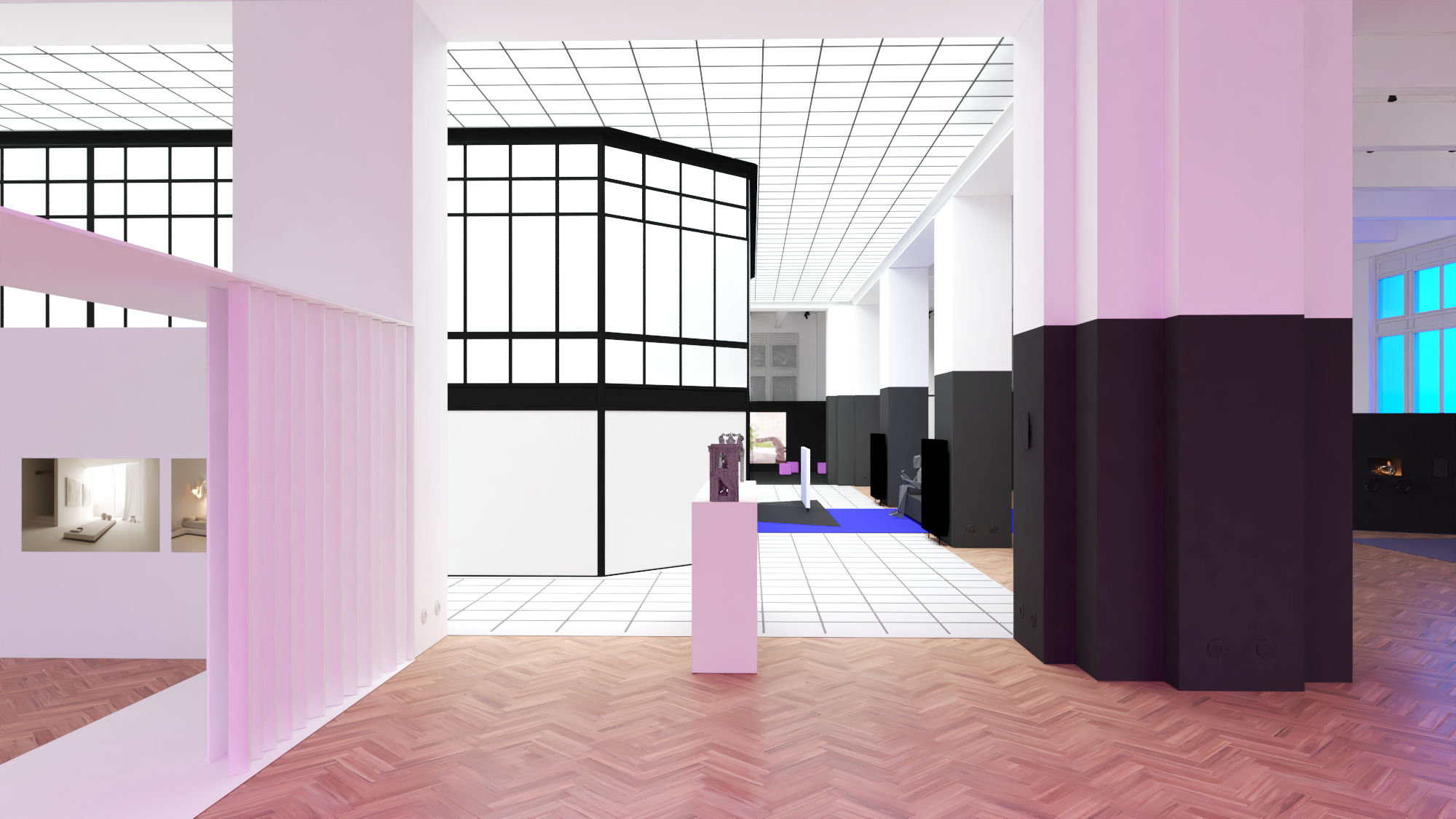
Exhibition view at the MAK, Vienna
© Some Place Studio
/glossary
An overview of terms used in this exhibition, generated by →Chat GPT3, reviewed and refined by human editors.
3D Modeling
3D modeling is the process of creating three-dimensional digital representations of objects, buildings, spaces, or scenes. It involves the creation of geometry, textures, lighting, and materials to produce a realistic or stylized model. 3D modeling is used in various fields such as film, game development, architecture, product design, and virtual worlds. The exhibition design was also planned with the help of such a 3D model.
3D scan
3D scanning is a technology used to convert physical objects, architectures, or landscapes into digital 3D models. For this purpose, special scanners with cameras and sensors are often used to capture objects based on their shape, texture, size, location in space, etc. In this way, millimeter-sized components or even entire planets can be digitized without having to reproduce them using laborious →3D modeling.
AI model
AI models are specific applications of →machine learning. An AI model is a computer program developed by training machine learning algorithms based on a large amount of data that is capable of performing specific tasks or making predictions, such as image recognition, speech recognition, or automated decision-making.
Algorithm
An algorithm is a step-by-step procedure for solving a problem. It consists of a sequence of instructions that can be executed by a computer or other device. Algorithms can be used to process data, perform complex calculations, or make decisions. Text-to-image algorithms such as →Midjourney, Dall-E, or Stable Diffusion have become increasingly popular with creators. In this context, the question of authorship is currently being debated: While human designers still provide the original idea or concept in the form of the text prompt, the interpretation and realization of the visualization is performed by the algorithm. Who is the actual creator of the work and what role do cultural, social, and technological factors play in its creation? Certainly, the use of algorithms can open up new and surprising possibilities of co-creation and collaboration and expand the creative process.
Cappricio
Capriccio (Ital. caprice) is a term in architecture that refers to a fantasy or dream representation of a building or landscape. Different architectural elements and styles can be assembled in fictional and often fantastic combinations to visualize architectural visions that are beyond the realm of the possible and do not serve any practical function. Architectures created with AI-based software such as →Midjourney or as →Dreamscapes are often capriccios.
CGI (Computer Generated Imagery)
CGI refers to images and animations (series of images) produced using computer software. They are often used in the film and video game industries to create complex effects and scenes that would not be possible using traditional methods. There are different reasons for using CGI, which can range from having more control of a situation or retouching mistakes to recreating images from past times.
Chat GPT
Chat GPT (Generative Pre-trained Transformer) is a powerful text-based →AI model based on the GPT architecture. It is designed to simulate humanlike conversations and can be used for a variety of applications such as chatbots, text generation, and automatic translation. It does this by tracing its way word by word through the text that is being generated.
CNC fabrication
CNC fabrication refers to the computer-controlled production of parts, entire component groups, or models from a variety of materials. However, the name CNC (Computerized Numerical Control) says nothing about how materials are processed. Rather, it is a collective term that refers to the fact that a machine is given positions in space with the help of a sequence of numbers, at which certain work steps are then to be performed. CNC fabrication methods such as 3D printing and 3-axis milling are techniques used to turn digital models back into physical objects.
Digital twin
A digital twin is a digital replica of a real object or system. Various data and sources are collected and located in a virtual model. This can be used to simulate different scenarios and configurations. Digital twins are often created on the basis of →3D scans.
Dreamscapes
Dreamscapes are digital environments that merge reality and fiction with the help of technological tools such as →rendering, →CGI or by using →AI models. In these utopian virtual places and spaces, the laws of the physical world are suspended. They can combine utopian, dystopian, bizarre, and surreal elements, rendering surfaces, textures, light, and materials with a degree of realism almost indistinguishable from a "real" photograph.
Game engine
A game engine is a software platform that enables developers to create computer games faster and more efficiently, manage the user interface, control the interaction with the computer's hardware, and optimize the game's performance.
Lore
Lore is a body of knowledge, traditions, and stories that have a certain meaning within a culture or group. It can include myths, legends, history, and customs that have been passed down through oral or written tradition. In the context of →worldbuilding and the →metaverse, "lore" can refer to the narrative and backstory of a virtual world or game. The lore of a virtual world can include information about the setting, such as the geography, technology, and political structure, as well as details about the different factions and characters that populate the world. Lore can help create a sense of immersion and depth in a virtual world. Lore is often created and maintained by the developers of the virtual world, but it can also be shaped and expanded upon by the community of players who inhabit it.
Machine learning
Machine learning refers to a type of artificial intelligence that allows computers to recognize patterns in data and make predictions without being specifically programmed. Instead, large numbers of reference datasets are used to train the machine. This means that the machine learns "on its own" from the given data. If these data contain certain world views and opinions, these are also transferred to the AI, which is often referred to as "data bias", a bias resulting from the processing of data based on historically accumulated data.
Metaverse
The metaverse is the idea of an immersive virtual world that can be visited and experienced by different users simultaneously. It is often considered the next stage of the internet (→Web3) and offers the possibility to integrate different applications, games, and services in a common virtual environment. The term "metaverse" was first used by science fiction author Neal Stephenson in his novel Snow Crash (1992), describing his vision of how a virtual reality-based internet might develop in the future. The term has been adopted in modern times by Meta (formerly Facebook).
Midjourney
The Midjourney →algorithm is an →AI model that can turn text into images. The algorithm can be activated by entering text prompts with the command "/imagine:". Based on the descriptive text, the algorithm generates four variations of images from which users can select and instruct the algorithm to generate further variations and refine them. Precise visual specifications can be defined to achieve different lighting or weather conditions, materials and textures, colors, environments, and stylistic references to specific architectural models (e.g., "in the style of John Lautner"). Midjourney learns from the users' choices and feedback, and improves its results over time.
Normal maps
Normal maps allow computers to detect the direction in which a surface is oriented or a surface normal is pointing. This allows for details to be defined or added to a surface without the need for compute-intensive geometry. They are often used in game development and architectural visualization to clarify the rendering of textures on 3D models and optimize the performance of computer games and applications. The color concept of the exhibition design is based on the color spectrum used in normal maps to specify the computer's representation of volumetric depth.
Portals
Portals are a concept in virtual space that refers to the transition from one virtual environment to another. They can serve as visual or physical separators or connections, helping users with orientation in →virtual space and allowing them to move from one environment to the next. The key visual of the exhibition poster features Space Popular's manifesto for the future of portals and virtual travel—The Fabric of Civic Teleportation—which outlines the key qualities needed to create a meaningful, fair, and civic infrastructure for the Immersive Internet →Web3.
Rendering
Rendering (literally "to represent") refers to the process of creating images from digital data. This often involves visualizing a 3D model with special software (so-called render engines) using simulated material properties and effects. It is also possible to use digitized textures of real objects, obtained, for example, from photographs, to represent surfaces.
Virtual space
Virtual space is a computer-generated environment that can be explored by users. It can be a virtual space displayed on a computer screen or an augmented or virtual reality (AR, VR) experienced with VR goggles or on a screen. Virtual space is used for games, simulations, architectural visualizations, the →metaverse, and more.
Web3
Web3 is the idea of a future version of the internet based on decentralized organization. Web3 uses blockchain technology to enable a new generation of decentralized applications and services that are not controlled by central authorities. Control over data, content, and applications will shift from individual large companies to users and communities.
Worldbuilding
Worldbuilding is the process of creating a fictional world or environment in books, movies, video games, or other media forms. It includes designing geography, landscape, architecture, cultures, physical laws, characters, mythologies, →lore, and (background) stories. In gaming, it also includes creating game mechanics and objectives.
/imprint
#imagine
#thenewvirtual
/imagine: A Journey into The New Virtual
10.5.2023-10.9.2023
An exhibition of the MAK
thenewvirtual.org
Curators
Bika Rebek, Architect and Principal, Some Place Studio
Marlies Wirth, Curator, Digital Culture and MAK Design Collection
Exhibition Design
Some Place Studio
Bika Rebek, Cameron Lintott
Graphic Design
Process—Studio for Art and Design
Martin Grödl, Moritz Resl, Matthias Schöllhorn
